海外傳真 | 展覽:Back-Bad-Bone,鹿特丹
導言
AIVA Gallery
目前就讀于比利時安特衛普皇家藝術學院的AIVA海外特派員盧雨曦,為讀者帶來荷蘭藝術家兼策展人 Karin van Paassen日前于鹿特丹Galerie Wind舉辦的個展《Back-Bad-Bone》。在藝術家所擅長的原始藝術與象征主義風格中,觀眾不難感受到被灌注于作品中的強烈精神性,并感知到藝術家在創作過程中所經歷的精神壓力與肉體痛苦。
雨曦的訪談對話里,我們不僅看到藝術家的自我剖析,也看到了小記者的摸索與成長——感謝雨曦為AIVA當代首飾公眾號的讀者帶來了如此真誠溫暖的訪談。
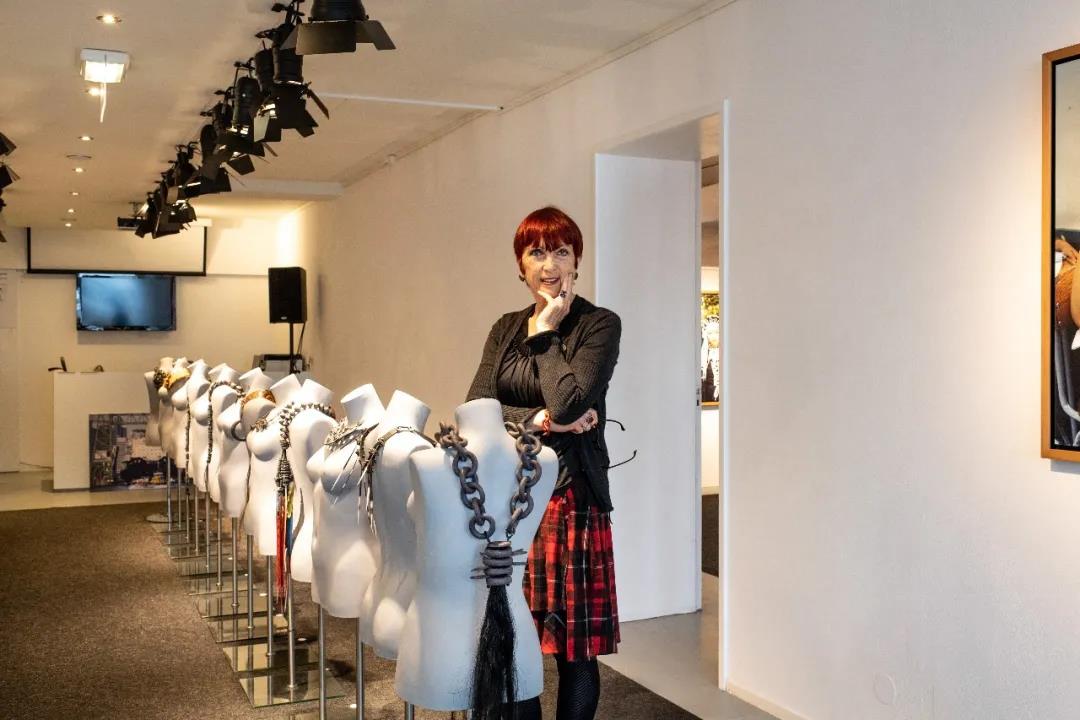
Karin van Paassen with her works
Photographer: Adriaan Backer
卡琳·范帕森和她的作品
攝影師:阿德里安·貝克爾
“I never make a drawing, I always follow my intuition during the making process.”
“創作過程中,我從不繪圖。我總是跟隨我的直覺。”
關于藝術家
About the Artist
卡琳·范帕森
(Karin van Paassen)
出生于1954年,荷蘭
作為策展人,
Karin 30 多年來在國內外發起和組織了
多個文化和教育項目,
她的展覽和教育項目主要涉及
設計、時尚、氣味、紡織品、攝影
和建筑等領域,
尤其偏愛現代珠寶和民族珠寶。
16 年來,
Karin為 WEB.Foundation 開發項目,
特別關注亞洲和非洲的艾滋病毒/艾滋病。
她還積極擔任多個組織的董事會成員,
并舉辦講座和研討會。
貫穿她職業生涯的主題是
連接機構和專業人士,
以及分享知識。
Karin曾經是一名精神科的護士,
1981年她開始學習絲網印刷,
在專供面料印刷的公司工作。
1982年至1986年,
她開始從事時尚設計與生產
以及室內產品的設計工作。
Karin對首飾有著畢生的熱情。
她是一名狂熱的民族首飾收藏家,
在各國旅游時經常會收藏
富有當地民族特色的首飾。
她常常被首飾在不同文化中的重要性,
其非常規的材料,
奢侈華麗的裝飾,
權力的象征而著迷。
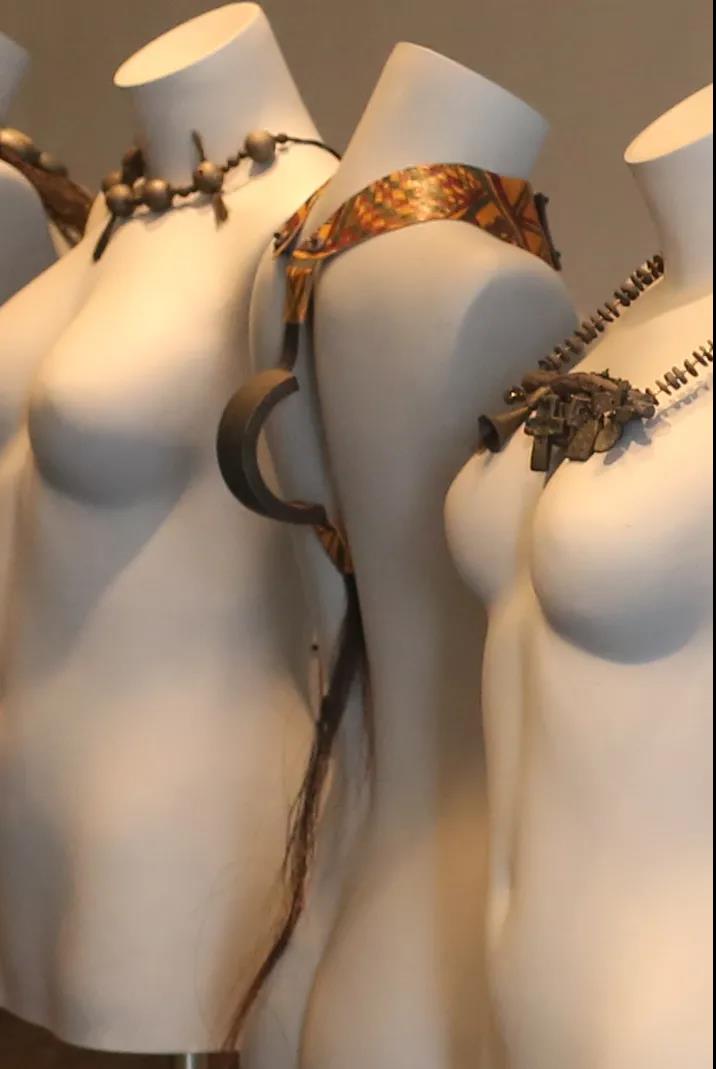
Photo by Yuxi Lu
Karin van Paassen
Born in 1954, the Netherlands.
Karin used to be a psychiatric nurse. She started training in silk screening in 1981, working in a company that focused on textile screen printing.
And she started on design and production of fashion and interior products during the year of 1982 – 1986.
She has had a lifelong passion for jewellery.
She is an avid collector of ethnic jewellery,
most of which she discovered during her extensive travels.
She is fascinated by the significance of jewellery in different cultures, the surprising use of unconventional materials, the lavishly opulent decorations and the power which is often attributed to jewellery.
As a curator Karin has initiated and organized cultural and educational projects, both nationally and internationally, for over 30 years.
She developed exhibitions and educational projects about -among other things - design, fashion, smells, textiles, photography and architecture, with special preference for modern jewellery and jewellery of ethnic origin.
For 16 years she has developed projects for WEB foundation, with a special focus on HIV/AIDS
in Asia and Africa.
She is also active as a board membe for a number of organizations, and she gives lectures and workshops.
The theme that runs through her career is connecting institutions and professionals, and sharing of knowledge.
Jewellery exhibitions and shows(part)
首飾展覽(部分)
1997 Water, jewellery show in a watertower, Monster, the Hague
2006 Cross-over, jewellery exhibition at Galerie Lous Martin, Delft
2014 -2016 Gris Gris; jewellery workshops, show and tv programs, Rotterdam. In collaboration with Maastricht Academy of Fine Arts and Design & Boa Producties
2017 Gris Gris; jewellery exhibition in CODA Museum, Apeldoorn; jewellery&films
2019 Lectures about project Gris Gris in Shanghai and Jingdezhen (China)
2020 Concept & realization book ‘MyJewel’ with 100 stories about jewellery
2018 Jewellery project: Dutch Designers & Chinese Crafsmen, Shanghai, China
Exhibitions & educational projects for Historical Museum Rotterdam
鹿特丹歷史博物館的展覽和教育項目
1988 - 2001 Kijkje achter de schermen
Dag rondom het hoofd
Show with fashion designers from Rotterdam
Dessins
Binnenkant Buiten
Kinderen in het Nieuw
Vervreemde Objecten
Variaties, part of Kleding op de Bon
Kleed – en versiergedrag in alle culturen
2002 100 jaar accessories, part of Uitgaan in Rotterdam
2002 - 2003 Ro-oots, designers from Rotterdam
2003 Ruik Rotterdam, 100 years smells in Rotterdam
2008 Bridges to Fashion; exchange between Turkish and Dutch designers with shows, a symposium, an exhibition. In collaboration with Trafik Foundation
關于展覽
About the Exhibition
Introduction of exhibition--Back-Bad-Bone
(Text from Galerie Wind)
Back-Bad-Bone 展覽介紹
(內容來自Galerie Wind)
大型的背部首飾是本次展覽的主線。Karin 做了14件由黑色瓷珠,骨頭和物件組成的大型背部首飾,與護身符,馬毛和自然材料相結合。她在中國的陶瓷之鄉景德鎮制作瓷器串飾。中國的歷史文化對Karin的作品有深厚的影響。許多中國元素被融入其中,如硬幣、漢字和紅色元素。
紅色在中國象征著好運。
除了珠寶制作,卡琳還從事了30年的策展工作,在國內外組織了幾十個展覽和文化項目。
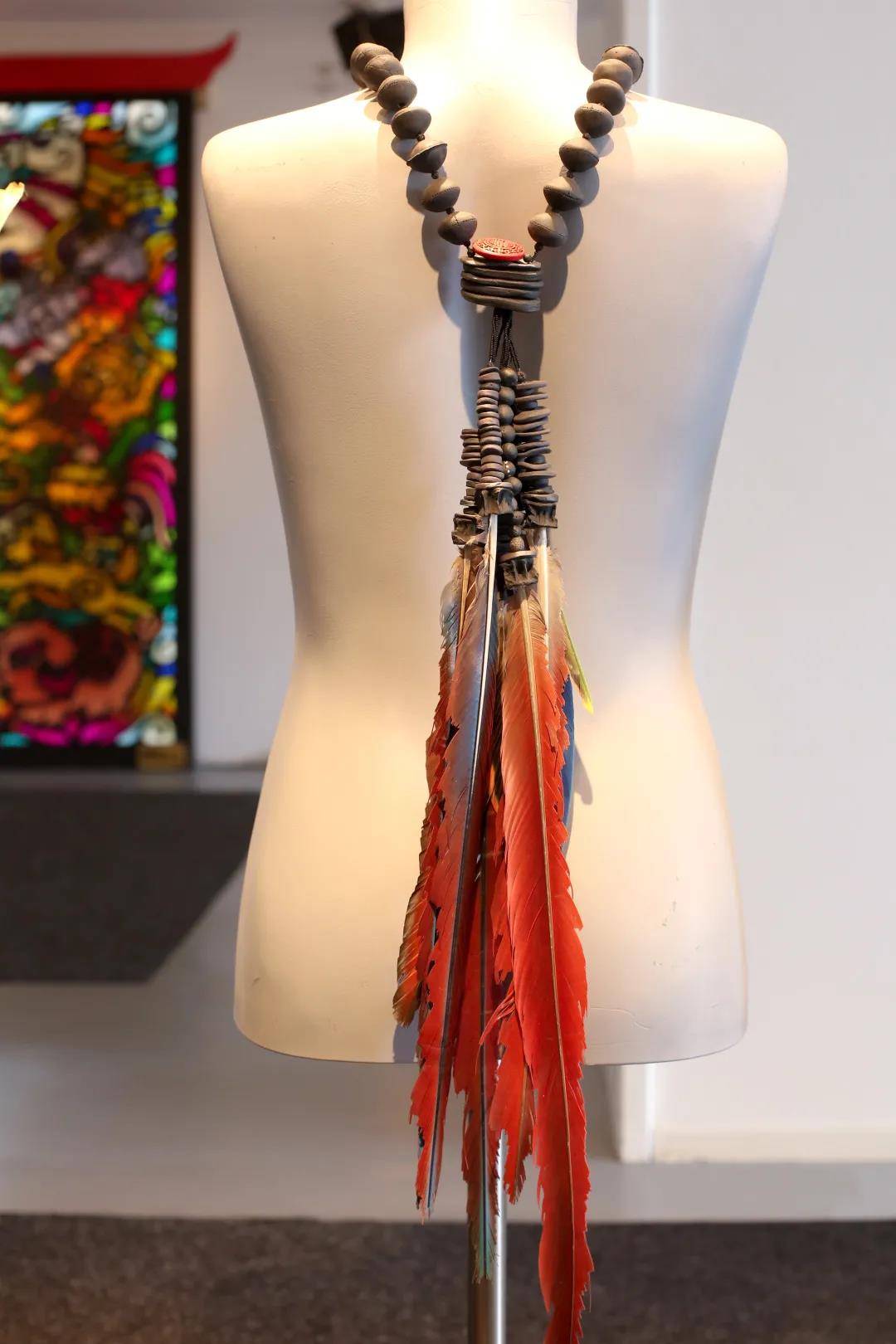
Photo by Yuxi Lu
The large back jewelry forms the backbone of the exhibition. Karin has made 14 large back jewelry with black porcelain beads, bones and objects, combined with charms, horsehair and natural materials. She makes the porcelain charms in the Chinese porcelain city Jingdezhen. The history and culture of China has a lot of influence on her work. Many Chinese elements have been incorporated, such as coins, characters and red accents.
Red is the color of luck in China.
In addition to making jewelry, Karin has been working as a curator for 30 years and has organized dozens of exhibitions and cultural projects at home country and abroad.
This interview is presented in the form of dialogue.
本次采訪內容以對話的形式呈現。
Karin: I always make porcelain in black. Of course, I love white porcelain. It's beautiful. But I always wanted to make black porcelain jewellery. I've made something of white porcelain. But no, it must be black. So, I have never changed it. The jewellery is always black.
Karin: 我總是做黑色的瓷器。當然,我喜歡白瓷,它是美麗的。但我一直想做黑瓷首飾。我曾經做過一些白瓷的作品。但我覺得不行,它必須是黑色的。所以我從來沒有改變顏色。我的珠寶總是黑色的。
Lu: May I know if the black color can show your feeling of back pain?
Lu: 黑色是否是為了體現你的背部的疼痛?
Karin: No, because before I had problems with my back, I always made it in black. So, it's a kind of a feeling. My own jewelry is also black. I love black. It has nothing to do with the meaning. It has always been like that. Also, when I was in Jingdezhen, still nothing white or other colors. It's just a feeling.
Karin: 不是的,因為在我的背部出現問題之前,我總是制作成黑色。所以這是一種感覺。我自己的首飾也是黑色的。我喜歡黑色,沒有任何象征。一直都是這樣。我在景德鎮的時候也沒有制作白色或其他顏色。黑色對我來說就是一種感覺。
Lu: So black is like your language, your symbolic color?
Lu: 所以黑色就像你的語言,具有代表性的顏色是嗎?
Karin: Yeah. People would always say "Oh yeah this is Karin" when they see my work.
Karin: 是的。當人們看到我的作品時,他們總是會說: 啊是的!這是karin的作品。
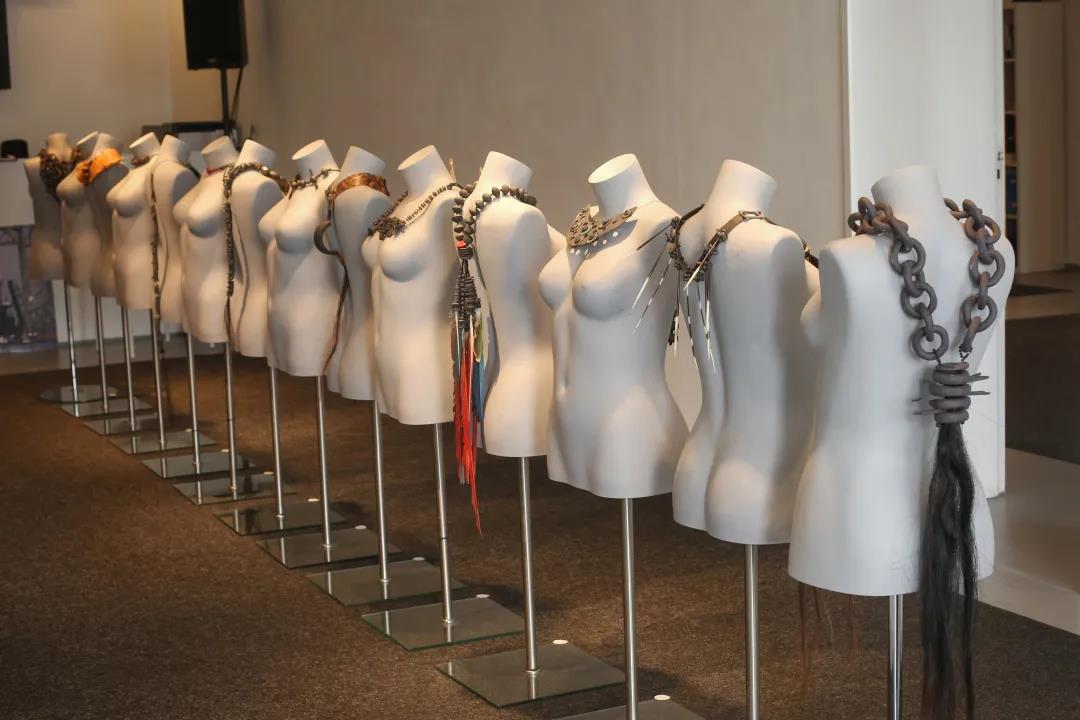
Image of the exhibition--Back-Bad-Bone
Back-Bad-Bone 展覽圖片
Photo by Yuxi Lu
Karin: Some things are always coming back, like horsehair and charms which are collected from all over the world. Let's say everything comes together in these jewellery. Let's have a walk.
Karin: 一些事物總是在不斷重現,例如馬毛和從世界各地收集的護身符。可以說,所有事物都匯聚在這些首飾上。我們走走吧。
Karin: It started here, because at that time I felt pain in my back. These are pins of a porcupine that I found on a street in Italy. I’ve kept them for years and years. When I started to make these works, I had a lot of pain. Because of that, I use these pins as all of them are very sharp.
Karin: 故事從這里開始,因為在那個時候我受到背部疼痛的困擾。這些是我在意大利的街上找到的豪豬脊椎。我保存了許多年。當我開始制作這些作品的時候,我感到許多疼痛。因此我使用了這些豪豬脊椎,因為他們都十分鋒利。
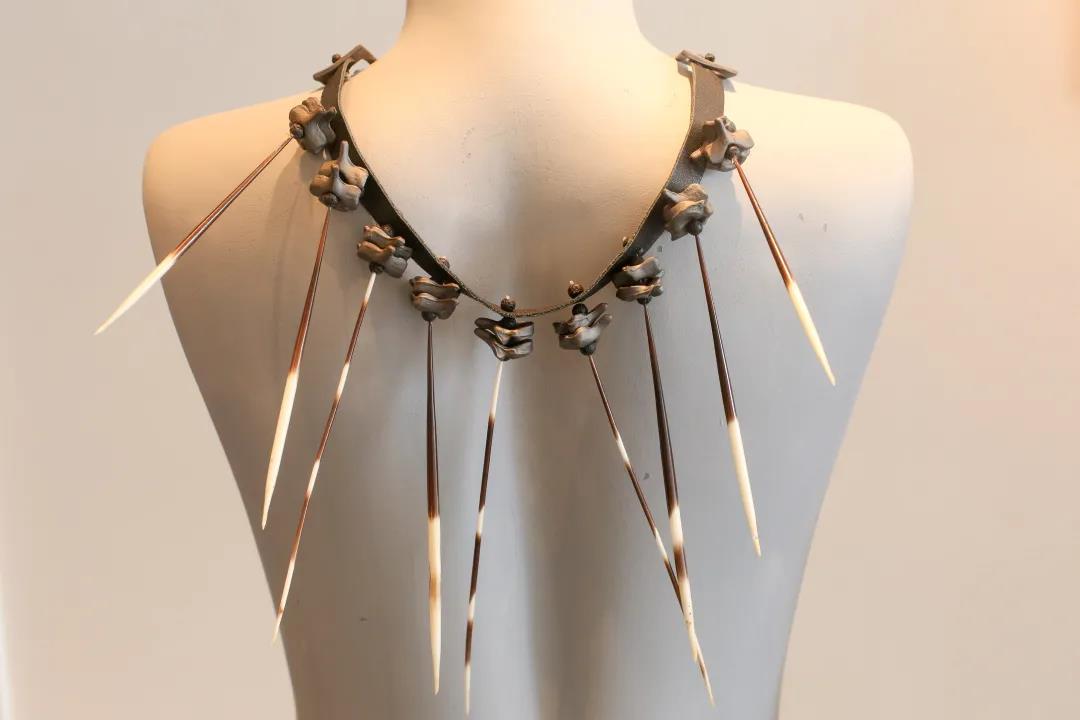
Photo by Yuxi Lu
Lu: These pins really make me think about hurt and pain.
Lu: 這些尖刺真的讓我聯想到疼痛的感覺。
Karin: When I was with a woman who always did the massage, she had a long spine mold on her desk to explain everything about the back. I took one out and brought it to Jingdezhen, China. And asked them to make a mold of it. Then we could make hundreds of this shape. Combining with lava stone.
Karin: 當我在接受按摩治療時,為我按摩的女士的桌子上有一個用來解釋背部一切的脊椎模型。我從中取出了一顆并帶到了中國景德鎮。請當地人為它制作磨具,然后我們就可以制作上百個相同形狀,并與火山石結合在一起。
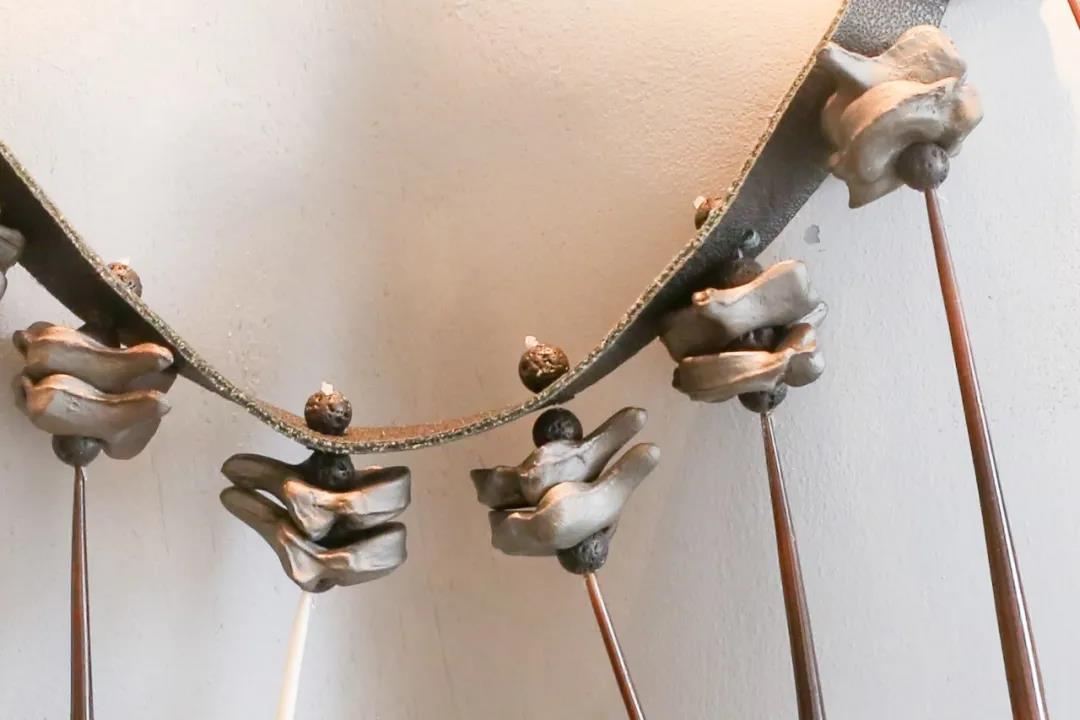
Detail
細節圖
Photo by Yuxi Lu
Karin: The works are displayed in different kinds of ways on the mannequins, to be shown on the front and the back of the body. Let’s look around.
Karin: 這些作品以不同方式在人臺的正面和背部交替展示。我們繼續走走看吧。
Karin: You can see all these holes and coins. At that time, I was in China, I thought I had to show something of China. So, I used all these old coins that I found in a marketplace. Because I was recovering. I made holes to show that I felt a kind of relief.
Karin: 你可以看見這些孔洞和錢幣。當時我在中國,我在想做些能夠展現中國的事物。所以我用了所有我在中國市場上找到的錢幣。當時我的背痛正在慢慢恢復,我做了這些孔洞表達一種舒緩的心情。
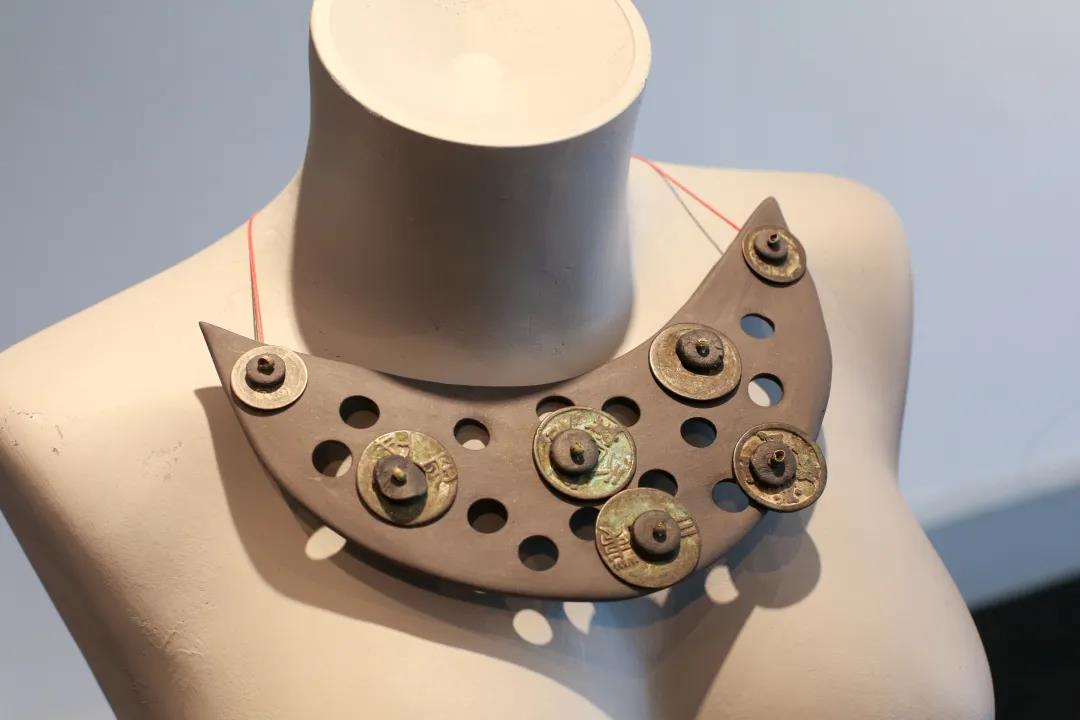
Photo by Yuxi Lu
Karin: For me it's not really a design development process. I was not just sitting at my desk to draw the design. And say “well, I'm going to make this”. No, it's just an organic way. It's a kind of a start of making.
Karin: 對于我來說,這完全不是所謂的設計過程。我不只是坐在桌子前繪制設計圖,然后說“好,我將這樣做。” 不是的,一切都是很自然的方式,是即刻開始制作。
Lu: In a natural way.
Lu: 十分自然的方式。
Karin: Yeah. I never make a drawing, I always follow my intuition during the making process.
Karin: 是的,創作過程中,我從不繪圖,我總是跟隨我的直覺。
Karin: This is the last Bad-Back-Bone. This is soft, all soft and colorful. I ended the making process with this one. It was a feeling that it had to be something soft. That's why I used all these feathers.
Karin: 這是Bad-Back-Bone的最后一件作品。是柔軟的,彩色的。我以這件作品作為制作過程的結尾。我有一種感覺它得是柔軟的事物。這也是我為什么使用這些羽毛的原因。

Photo by Yuxi Lu
Karin: All of these (clay plates) are made by hands. Those (clay spheres) are made with molds, because inside is hollow. You cannot make this by hand. I worked with an assistant who did all this work with the mold.
Karin: 這些(瓷片)全部是我手工制作的。那些(陶瓷球體)則是由磨具成型,因為它們內部是空心的,無法手工制作。我和一位助手一起工作,他用模具完成了這些所有工作。
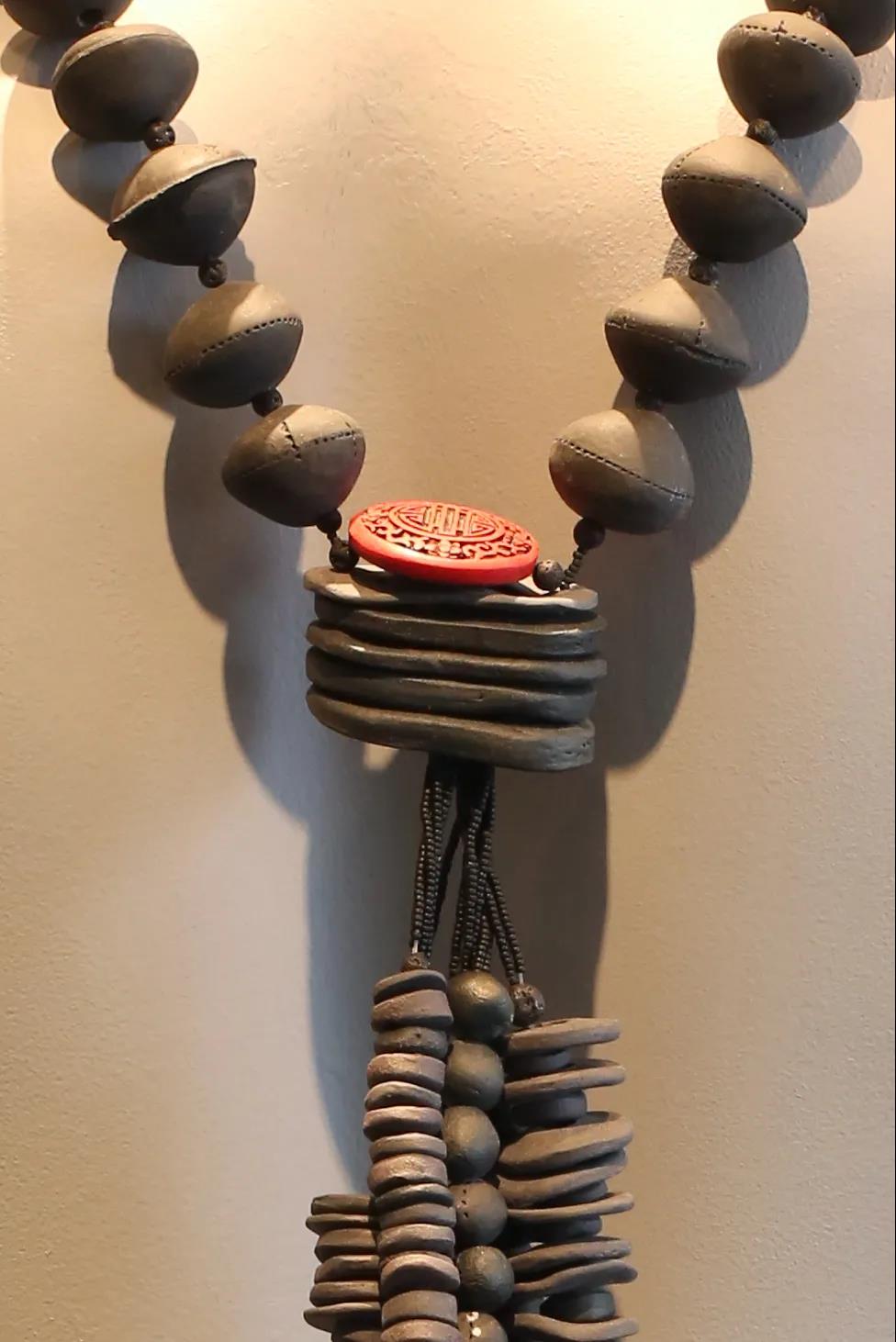
Photo by Yuxi Lu
Lu: Did you combine the two half-rounded parts together?
Lu: 你是將兩半空心圓拼合在一起的嗎?
Karin: Yes.
Karin: 是的。
Karin: In this piece, I want to show that for me the whole world is in this work. I have all kinds of beads and charms from all over the world. I pushed them in the clay, so the shapes you see are from all over the world, such as China and Africa. It's all printed in the clay and then I cut the shape out of it.
Karin: 這件作品,我想展示對于我來說整個世界都匯集在了這上面,我把我從世界各地搜集的珠子和護身符壓進泥土里,所以你看見的這些形狀是來自各個地方的,比如中國和非洲。它們都被壓印在了泥土表面,隨后我將它們的形狀切割了出來。

Photo by Yuxi Lu
Lu: Did you put all the amulets together to gather good luck?
Lu: 你是將所有的護身符聚集在一起來召集好運嗎?
Karin: Yes, it has something to do with this.
Karin: 是的,它確實與此有關
Karin: All of these things I also made by hand. Every piece took a lot of time. I have to try things that are not immediately done like this. Sometimes it takes two or three times to make. Sometimes I take it off and I think I have to change it. At first, I have an idea, and then I put it in my room for a week. And I think ‘no’, I take all out and make a new one. So, it sometimes takes two or three times to make something.
Karin: 這些物件也都是由我手工制作的。每一個都花了很長時間。我得嘗試一些無法立馬得到結果的事情。有時候會制作兩到三次。甚至有時會把它們取下來換掉。通常在一開始我有一個想法,把它們放在房間一周后覺得“這樣不行”,把他們全部取出再重新制作。所以有時候會花兩到三次來制作一些作品。
Karin: I always have this leather which was from my brother who worked in Africa. The Toeareg (men of the desert) painted the leather and they use it on the horses.
Karin: 我一直有這種皮革,是從我曾在非洲工作的哥哥那里得到的。圖阿雷格人(住在沙漠的人們)通常在皮革上繪制圖案,用于裝飾馬匹。
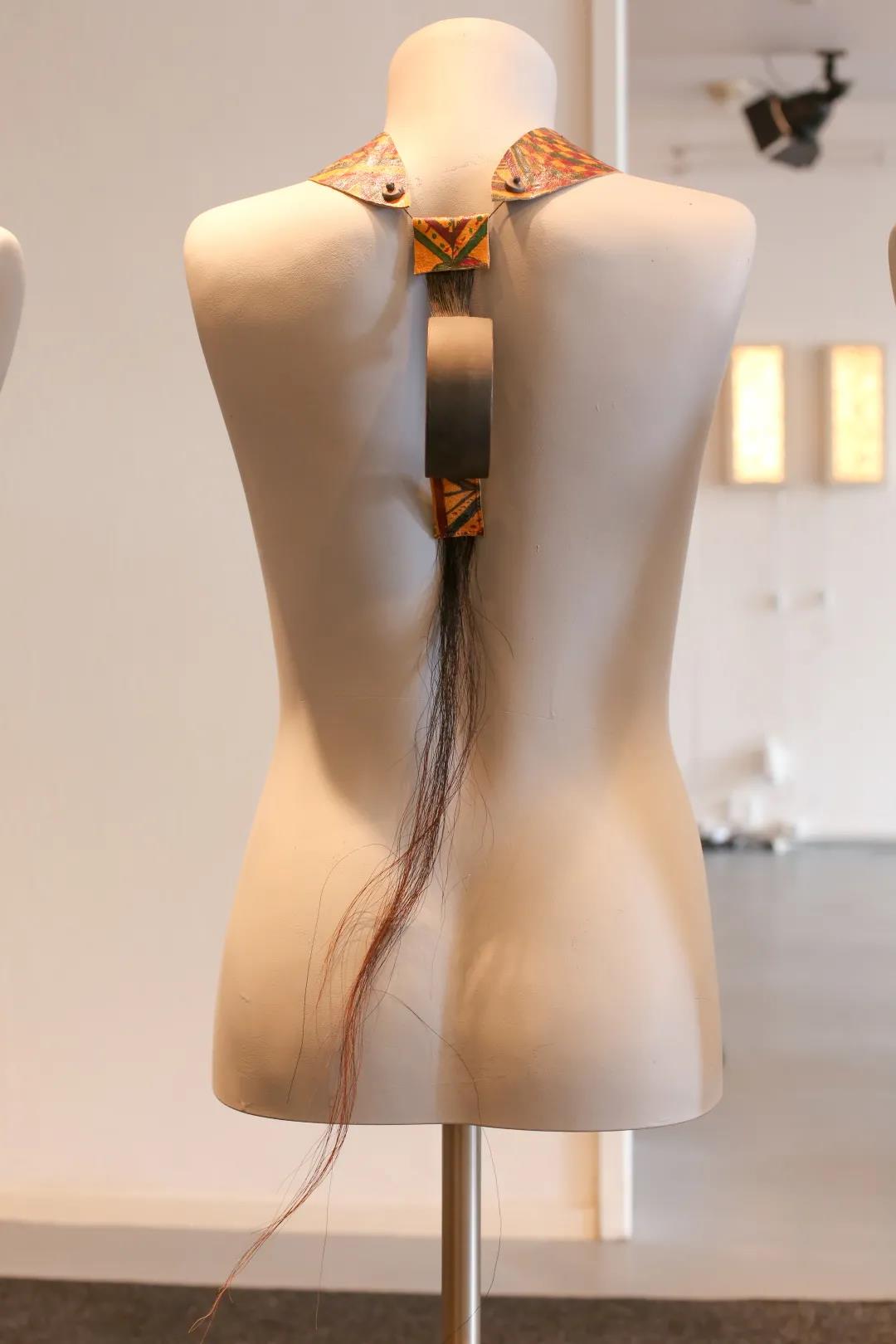
Photo by Yuxi Lu
Lu: For sitting place?
Lu: 用于馬鞍嗎?
Karin: For sitting on it, for boots, for all kinds of things. I love it. It is also part of my life because I've been a lot of times to Africa.
Karin: 用于馬鞍,靴子,各種事物。我很喜歡它。這也是我生命中的一部分,因為我曾經去過很多次非洲。
Lu: And you also connect with the horsehair in this piece.
Lu: 在這件作品中你也用了馬毛進行結合。
Karin: You see, there is still the shape of the back. Sometimes my back felt like this. It felt like hurt and pain. And still, it is hollow. It's a combination of thinking about my back and feeling. I tried to find all kinds of forms to show how I felt.
Karin: 你看,這也是一個背部的形狀。有時候我的背感覺就像這樣被卷曲,十分疼痛。它也是空心的。這是我思考背部和自我感受的結合。我嘗試尋找一切能夠表達我感受的表現形式。

Photo by Yuxi Lu
Karin: These are also hollow beads I made. Every time when I have new beads, I can change all kinds of things before placing them in the kiln. Again, combining with the lava stone.
Karin: 這些也是我做的空心珠子。每次我有新的珠子,在把它們放入窯爐之前,我能任意改變它們的形態。再一次與火山石結合。
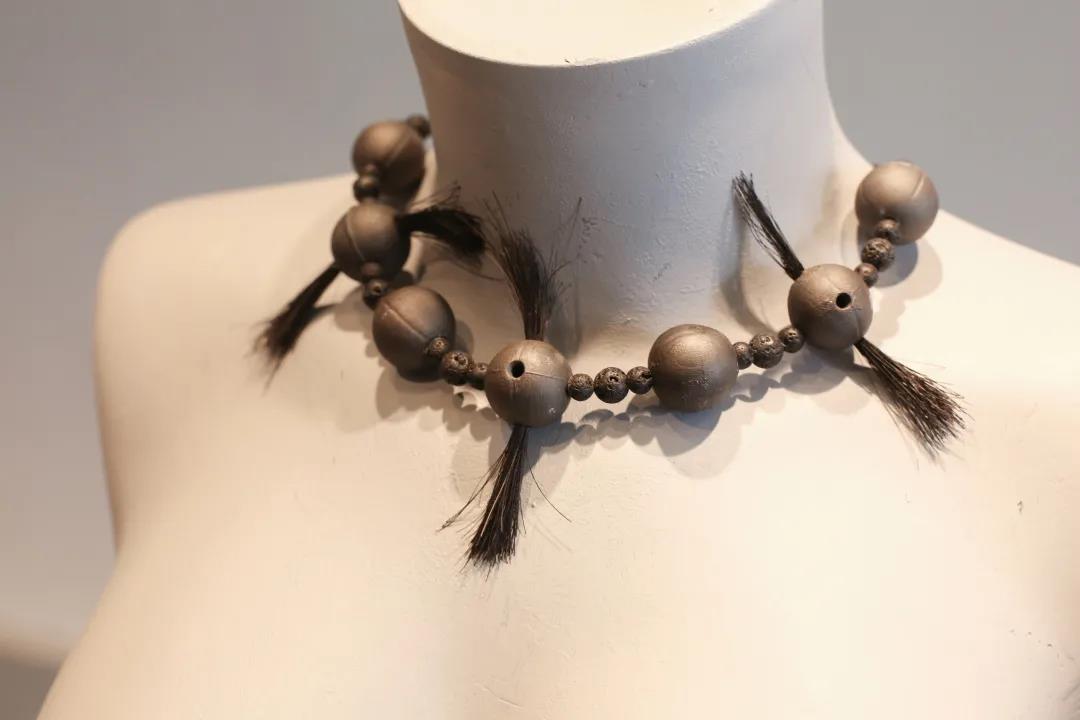
Photo by Yuxi Lu
Lu: I think the characteristics of the two materials (Porcelain and lava stone) seems quite similar yet different.
Lu: 我覺得瓷珠和火山石兩種材料的質感既相似又不同。
Karin: I also made a lot of eggs.
Karin: 我也制作了許多蛋。
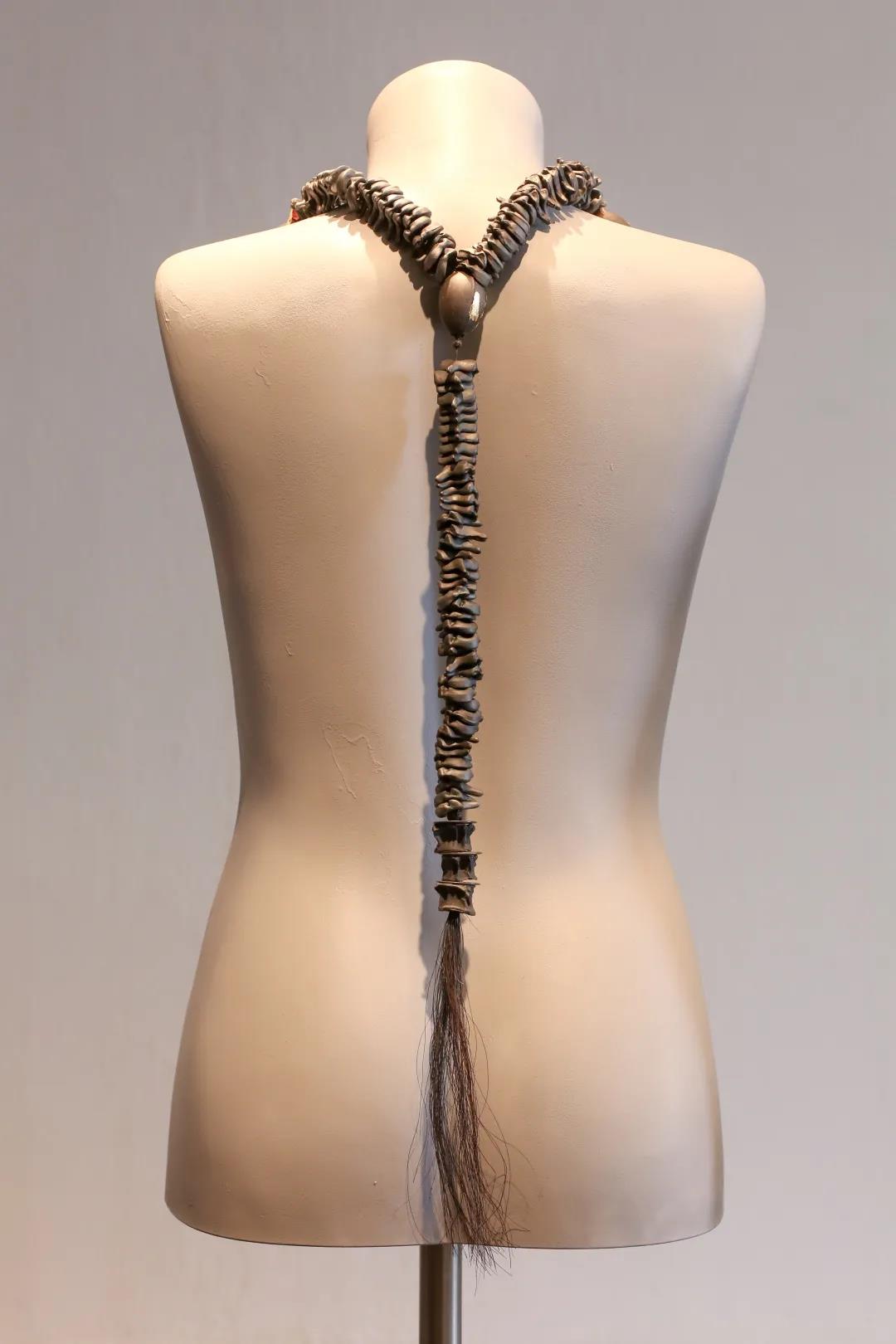
Photo by Yuxi Lu
Karin: It started with this one that I want to make black beads. It is a bone of a fish that I found on the beach where I live. And that was the moment that I thought I wanted to make black beads. I don't know why. It was a long time ago. And at that time, I didn't have these back problems. They made a mold out of fishbone. Then I could make a lot of pieces of this shape.
Karin: 這件作品是我想制作黑色瓷珠的開端。這是在我住的沙灘上發現的魚骨。就在那個時刻,我開始想要制作黑色瓷珠。我不知道為什么。很久以前的事情了。那個時候我還沒有背部疼痛的困擾。他們為這顆魚骨制作了模具。隨后我就可以翻制出更多相同的造型。
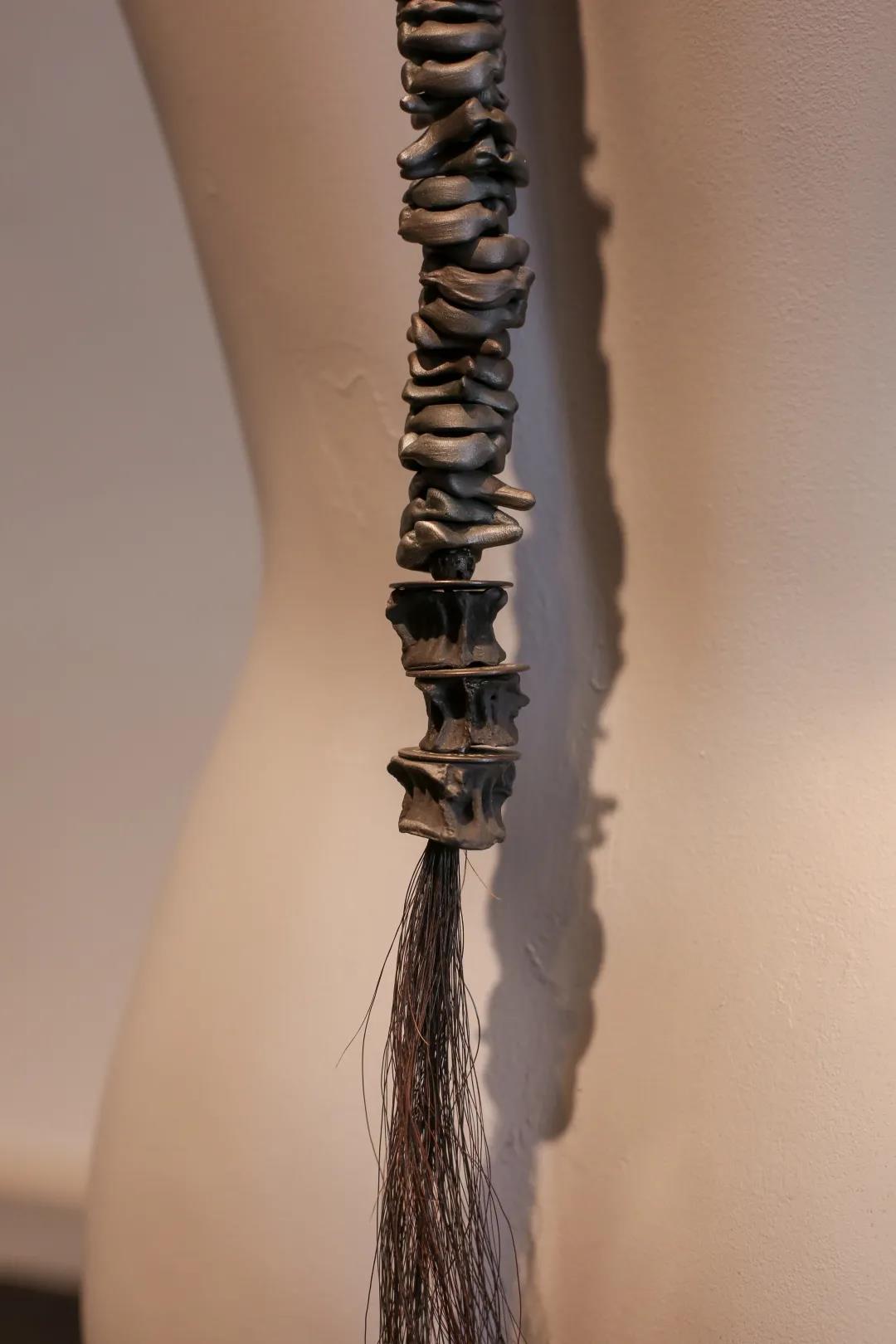
Photo by Yuxi Lu
Lu: Does the egg symbolize something?
Lu: 蛋是否象征著什么呢?
Karin: Yeah, it has something to do with fertility, and with new life. I recovered so that I have this kind of feeling.
Karin: 是的,與生殖力和新生有關。因為我痊愈了,所以我有那樣的感受。
Karin: They are skulls, symbol of death. It's not a natural stone. It is a kind of plastic. But I had to put it in it. I had to show something like skulls. I don't know. It just happened.
Karin: 這些是骷髏頭,死亡的象征。這不是天然石料,是一種塑料。但我得把它放進去。我得展現一些像骷髏一樣的事物。我不知道,就這樣發生了。

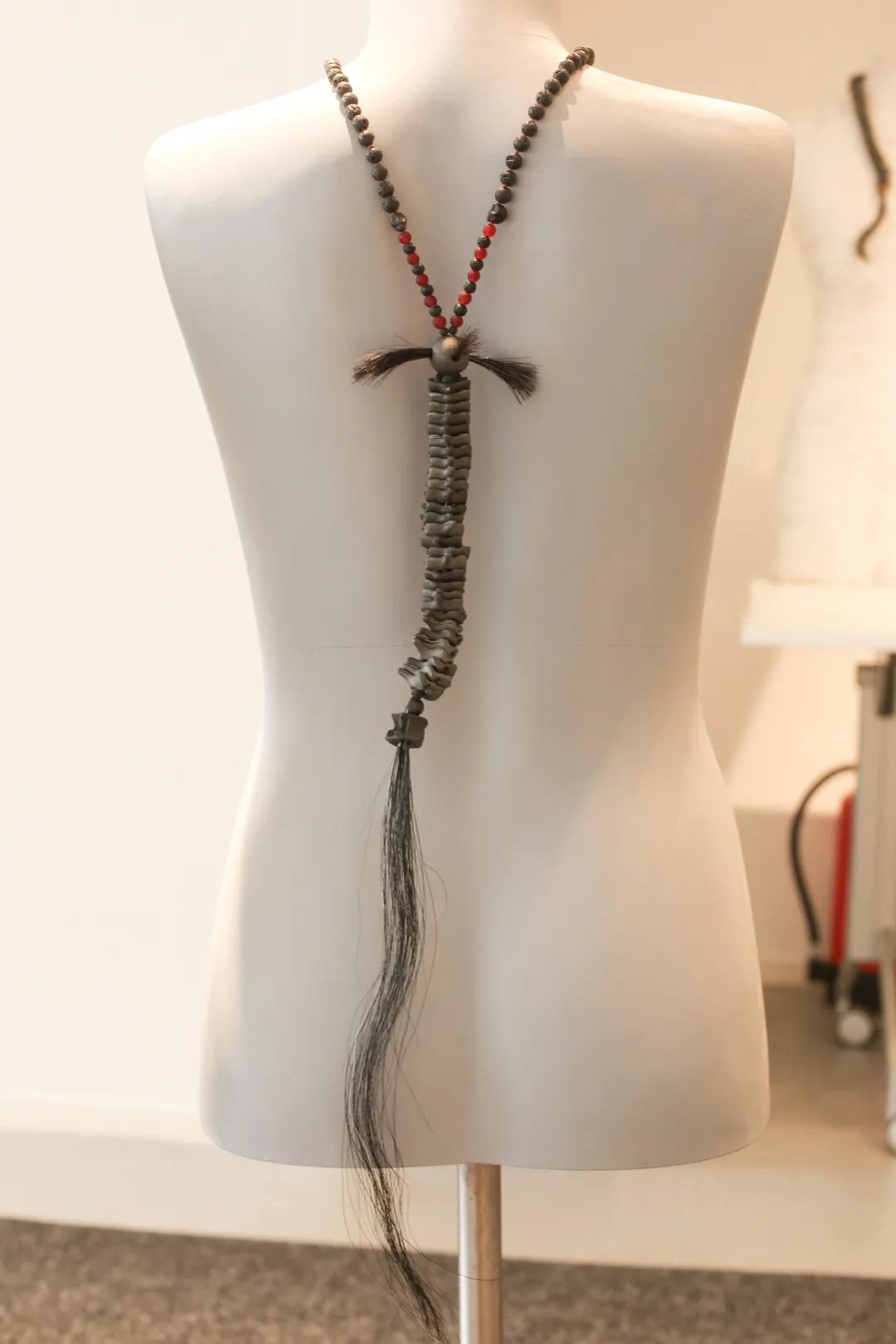
Backside of the work
作品背面
Lu: There's a Chinese word “福” in the middle of necklace that means happiness.
Lu: 我看見在項鏈中間有一個中文“福”字,意味著幸福。
Karin: Yes. It shows different feelings at the same time. That's how it worked. Because at that time I was sick. I didn't feel good. But at the same time, all my friends are so sweet to me. It's a combination of different feelings, mixed feeling.
Karin: 是的,它展現了同一時期的不同感受。這就是我這樣做的原因。因為在那個時候我生病了,感覺很糟糕。但與此同時我的朋友都對我十分的關愛。這是不同感受的結合,可以說是百感交集。
Karin: Here is broken back that I connected them with the silver from Senegal, west of Africa. Then, again, the tail. I don’t know why. Every time I have to do with horse tail. I also wanted to make them sharp.
Karin: 這是由塞內加爾銀連接起來的斷掉的脊背,塞內加爾位于非洲西部。我再一次使用了馬尾。不知道為什么,每一次我都會使用馬尾。我也想把脊背做得很鋒利。
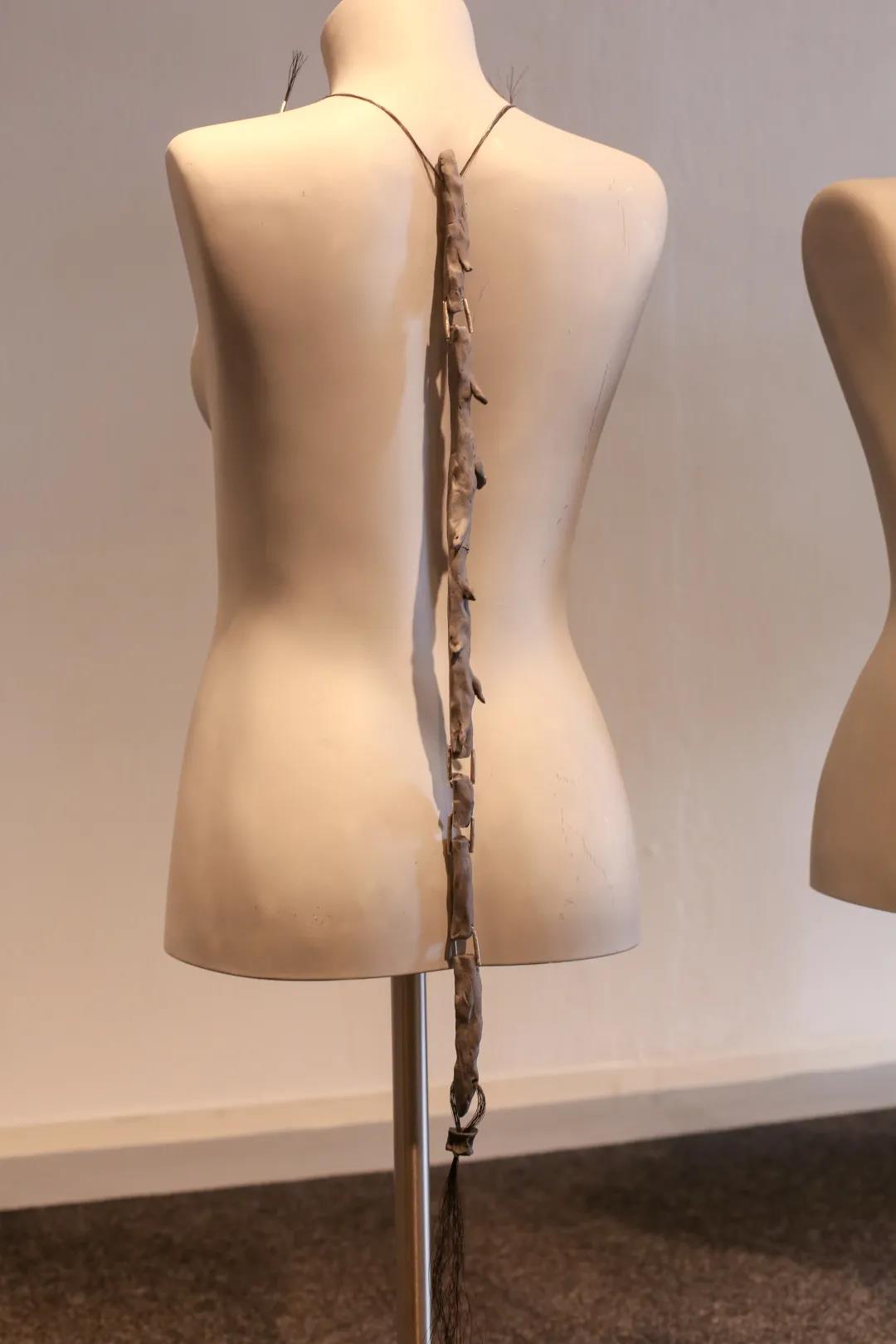
Photo by Yuxi Lu
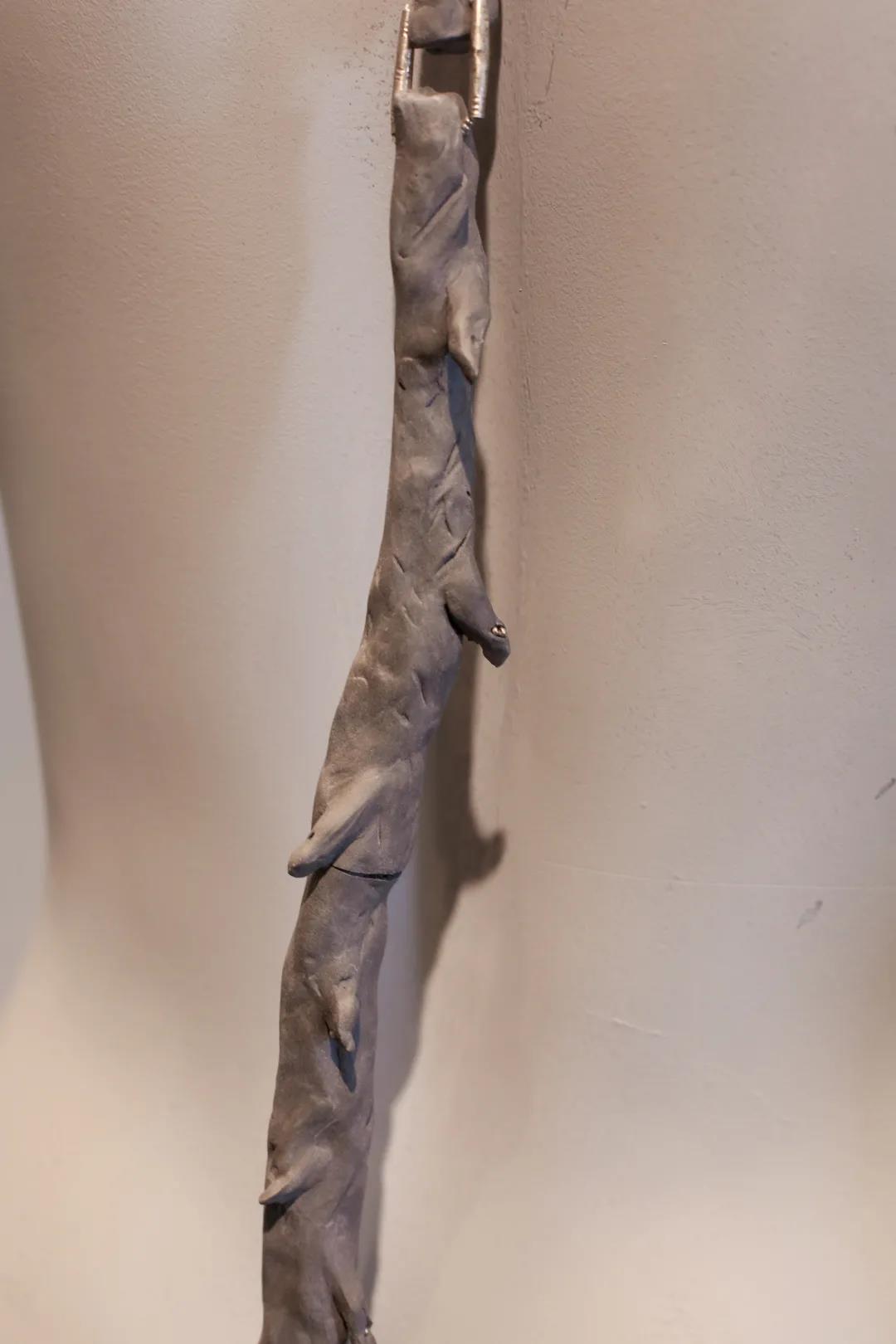
Details
細節圖
Karin: I also wanted to make them (bones) in front. And also made golden ones. I painted them in gold before placing them in the kiln. So that it has very thin coverage of gold.
Karin: 我也想把骨頭擺放在正面,并把其中兩個骨頭做成金色。在放入窯爐之前我在它們表面刷了一層金色涂料。所以在燒制之后便形成了一層很薄的金色涂層。
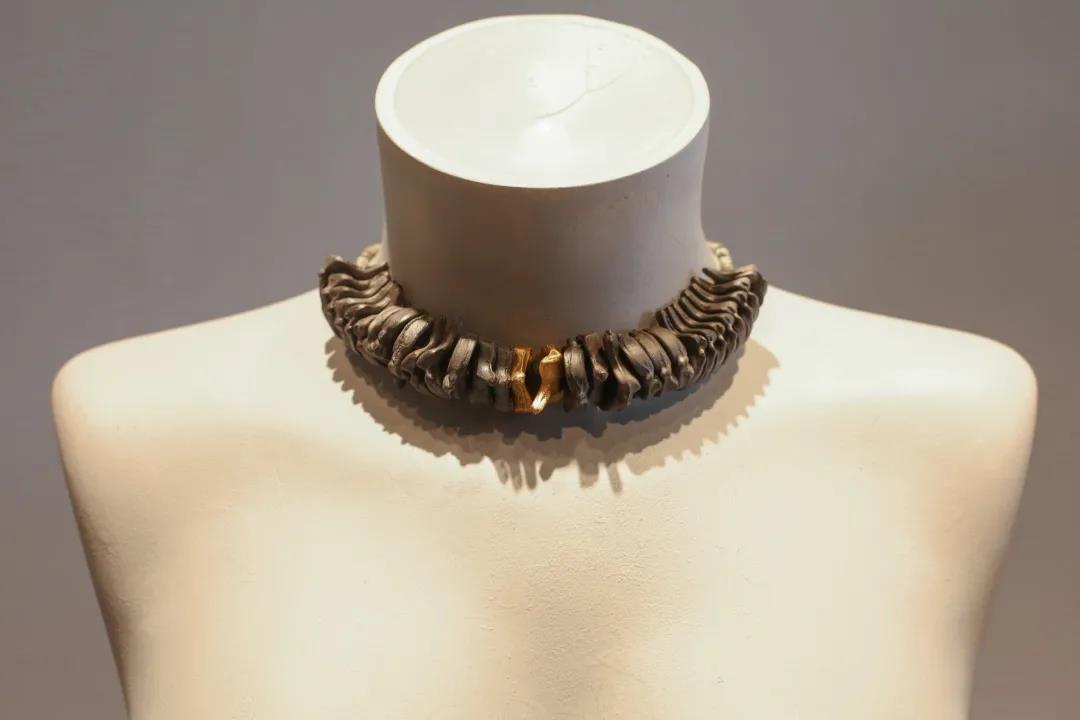
Photo by Yuxi Lu
Karin: This is also the leather from the Toeareg of Africa. It (The middle part) was kind of a feeling to hide the bones.
Karin: 這件作品的皮革也是來自非洲的圖阿雷格人。(中間部分)有一種把骨頭藏起來的感覺。

Photo by Yuxi Lu
Lu: I can also feel the contrast between the softness of leather and the hardness of bones.
Lu: 我也能感受到柔軟的皮革和堅硬的骨頭之間的反差。
Karin: These (both sides) are also horsehair which is also very soft.
Karin: (兩端的)馬毛也十分柔軟。
Karin: This piece has nothing to do with this theme. But I just wanted to show it. There was a contest in Shanghai -- the 2nd edition Contemporary Art Jewelry Exhibition 2021 themed “Intimate Relationship” by VONMO studio. This one was selected by the exhibition. And the exhibition will be held in Shanghai during the September of 2021. They asked people to make a piece of jewelry that had to do with intimate relationships. I thought I want to make a jewel that has to do with my family - My brothers and my sister. We were 5. And my youngest brother passed away. I thought I make five parts. We call it Medaillon in French (a piece of metal shaped like a large coin, worn as jewellery on a chain around the neck. An expression of faith). It has to do with Christianity. I asked my brothers and my sisters for their jewellery and I push all beads in clay and put them together.
Karin: 這件作品與本次主題沒有關系。但我只是很想展示它。上海有一個投稿征集-由VONMO studio舉辦的第二屆當代首飾展,主題是“親密關系”。我的這件作品成功入選,將于2021年九月在上海展出。主辦方要求參加者制作一件與親密關系有關的首飾。我想制作一件與我家人相關的首飾-我的兄弟姐妹,我們一共五個人。我最年輕的兄弟去世了。我想做五個部分。法語中我們稱它為“Medaillon”(一種外形類似于大型錢幣的金屬,通常附在鏈子上作為首飾佩戴在脖子上, 作為一種信仰的表達)。它與基督教有關。我向我的兄弟姐妹們收集了他們自己的首飾,將它們壓在泥土上,并擺放在一起。
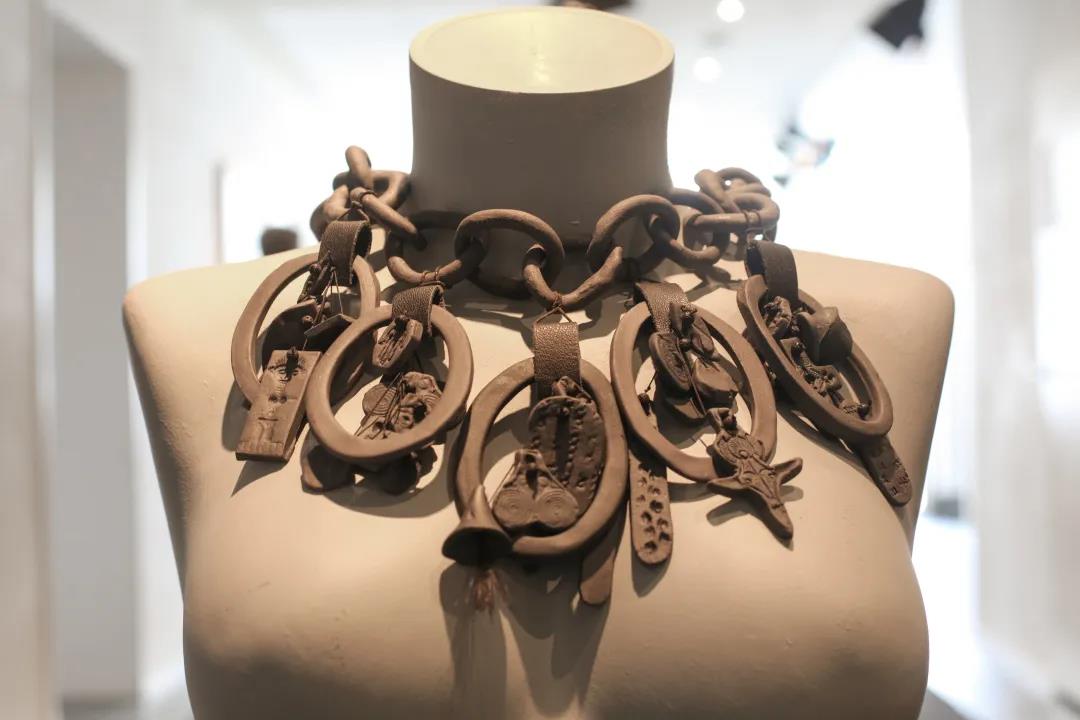
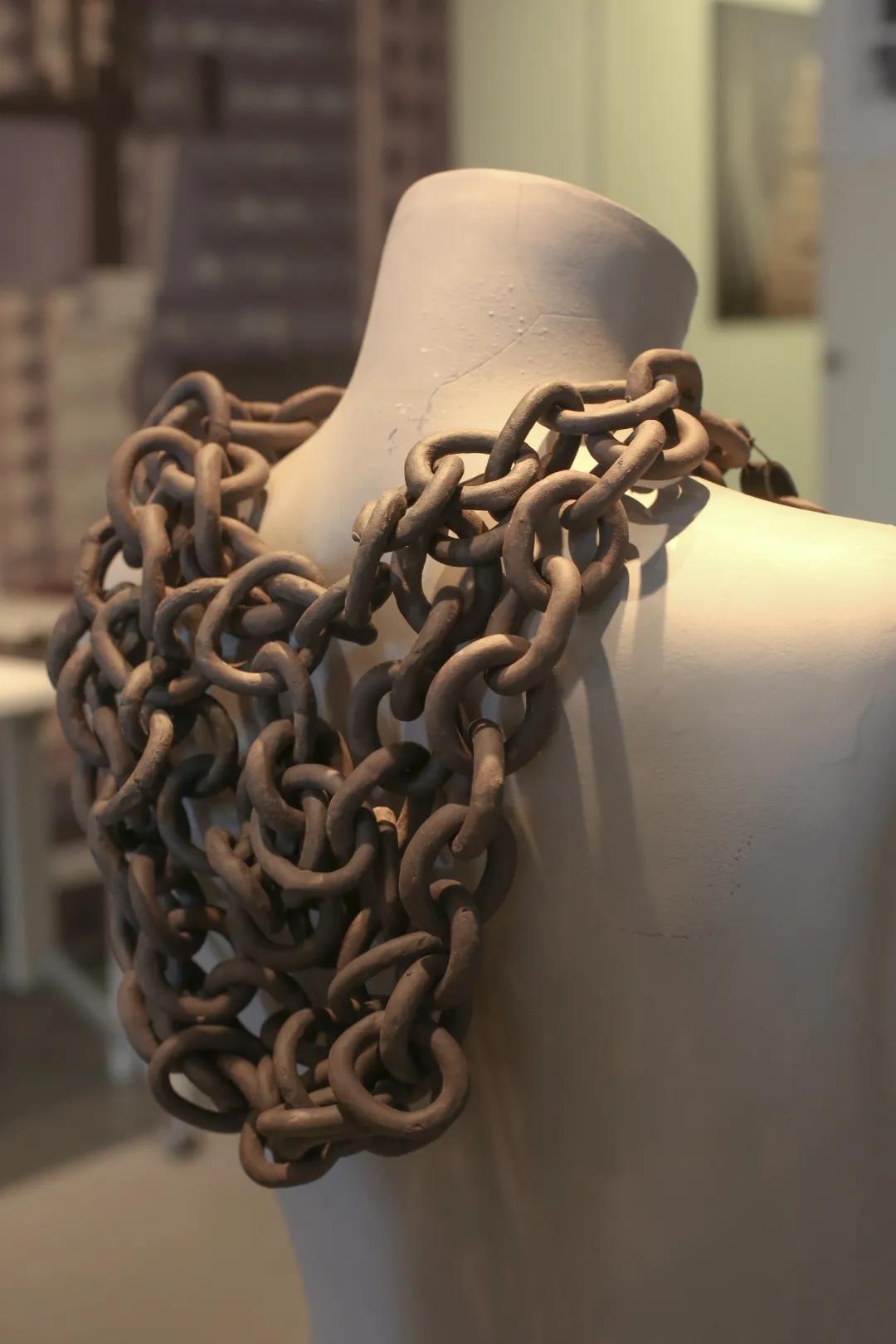
Photo by Yuxi Lu
Karin: And this (clay circle hanging on the back in the right picture) symbolizes the hair of my brother. He had hair like the African people with all these small curls. We are connecting with him. Because I like this piece so much. I thought I want to show it at this exhibition also.
Karin: 而這個(位于背部卷曲的陶瓷圓環)象征著我已去世的兄弟的頭發。他有著像非洲人一樣細小的卷發。我們所有人和他緊緊相連。因為我太喜歡這件作品了,所以我想在這次展覽中展示它。
Lu: It looks very harmonious with other pieces.
Lu: 這件作品與其他作品擺放在一起也十分和諧。
Karin: When I use the thread, I like to use a red one, because it has to do with China.
Karin: 當我使用線繩的時候,我喜歡用紅色的,因為它和中國有關。
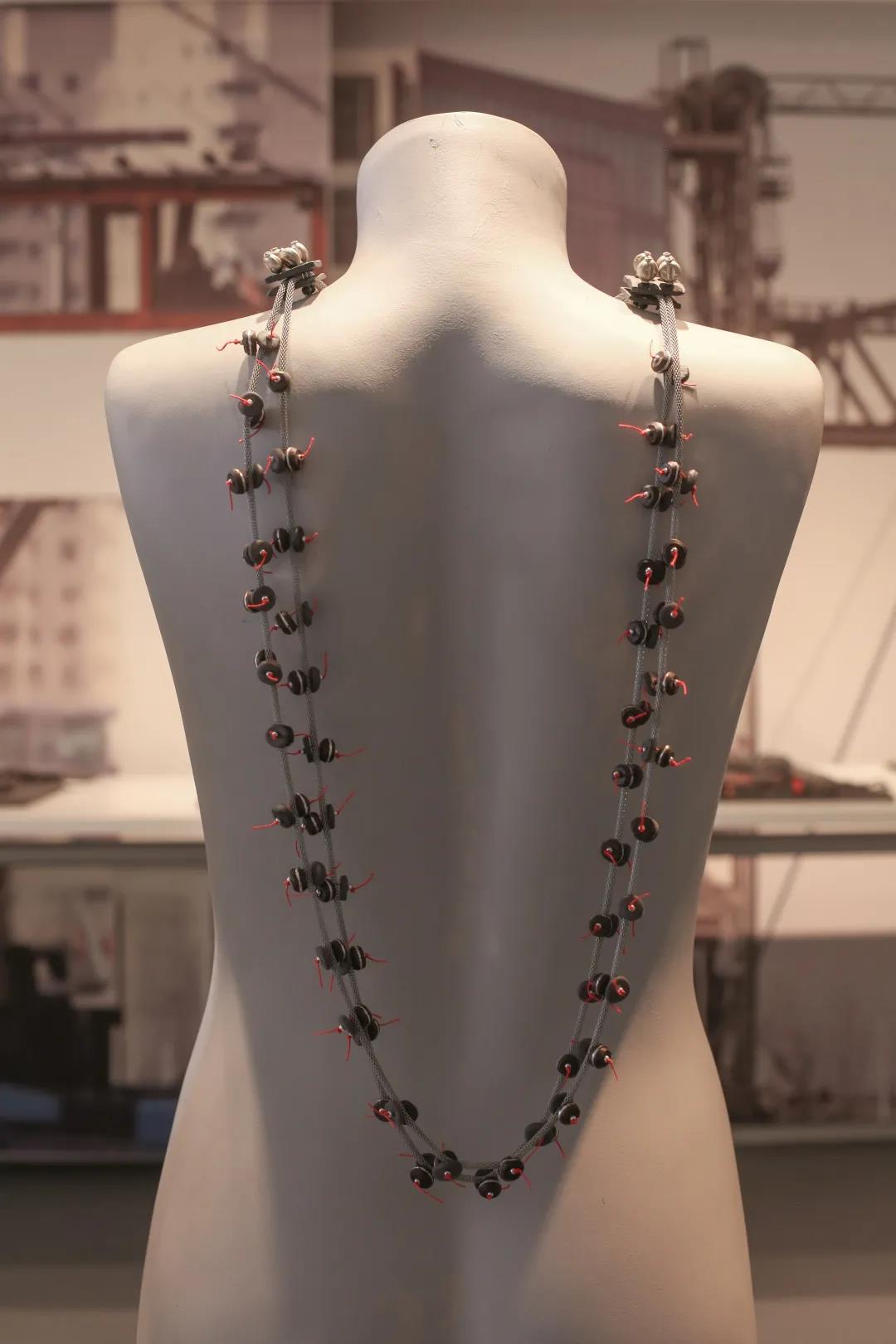
Photo by Yuxi Lu
Lu: The symbol of luck.
Lu: 象征著好運。
Karin: Yes.
Karin: 是的。
Karin: These are beads from Mali, west of Africa. These have to do with death. It's always death and life.
Karin: 這些珠子來自位于非洲西部的馬利。它們與死亡有關。總是關于生與死。
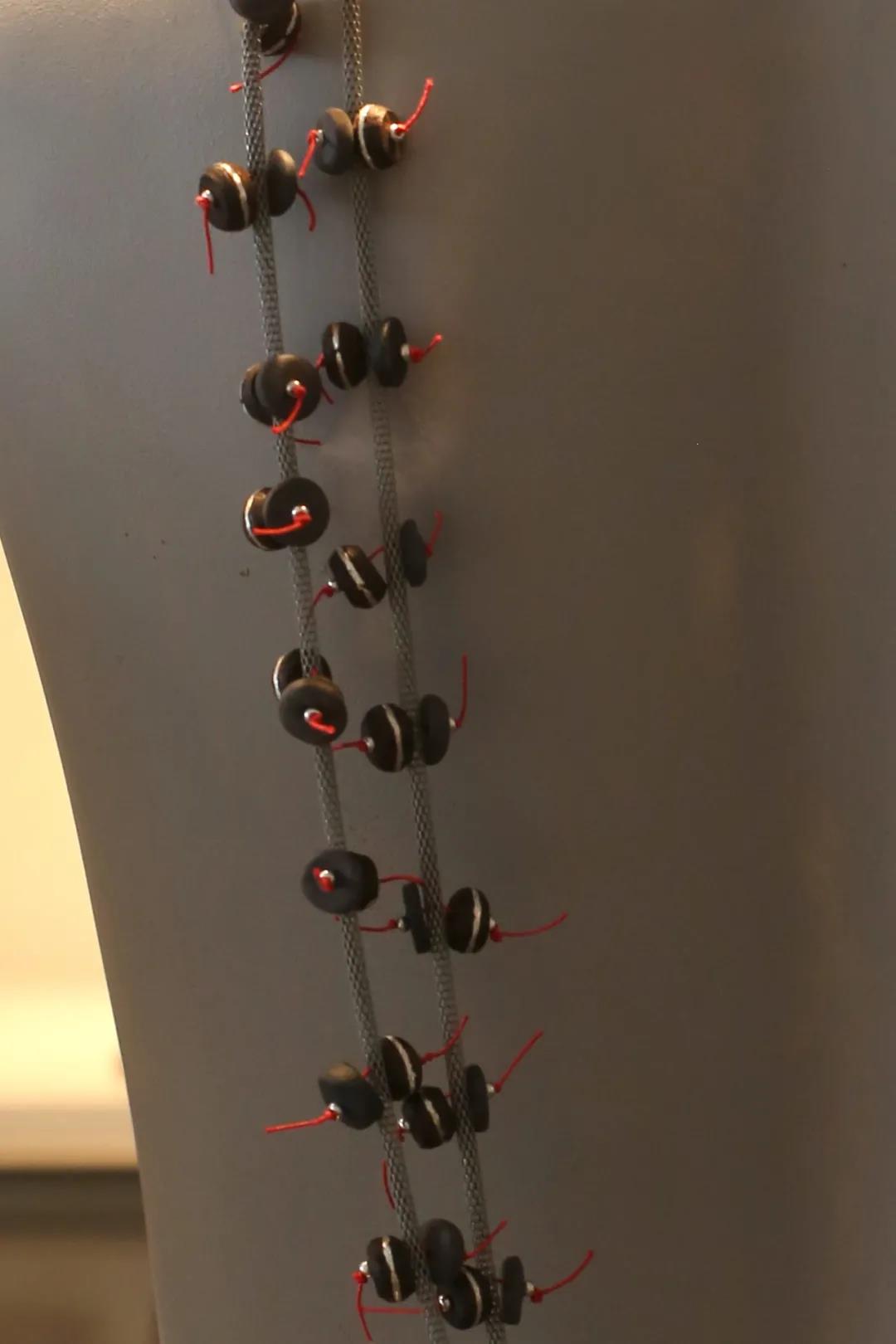
Details
細節圖
Photo by Yuxi Lu
Karin: This is another idea of backbone. There is also a golden one. These beads are from western Africa.
Karin: 這是關于背脊的另一個想法。里面也有一塊金色的。這些珠子來自非洲西部。
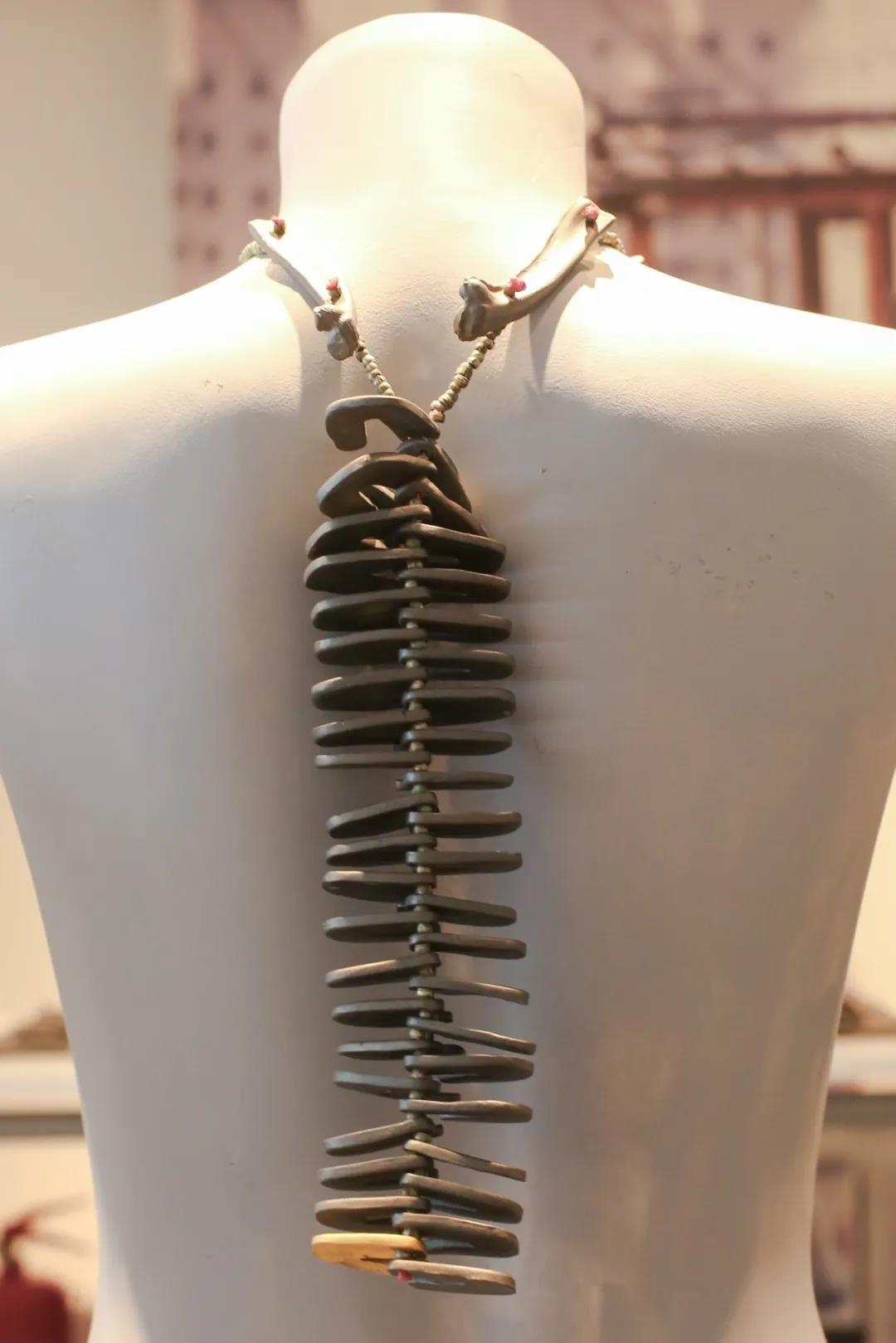
Photo by Yuxi Lu
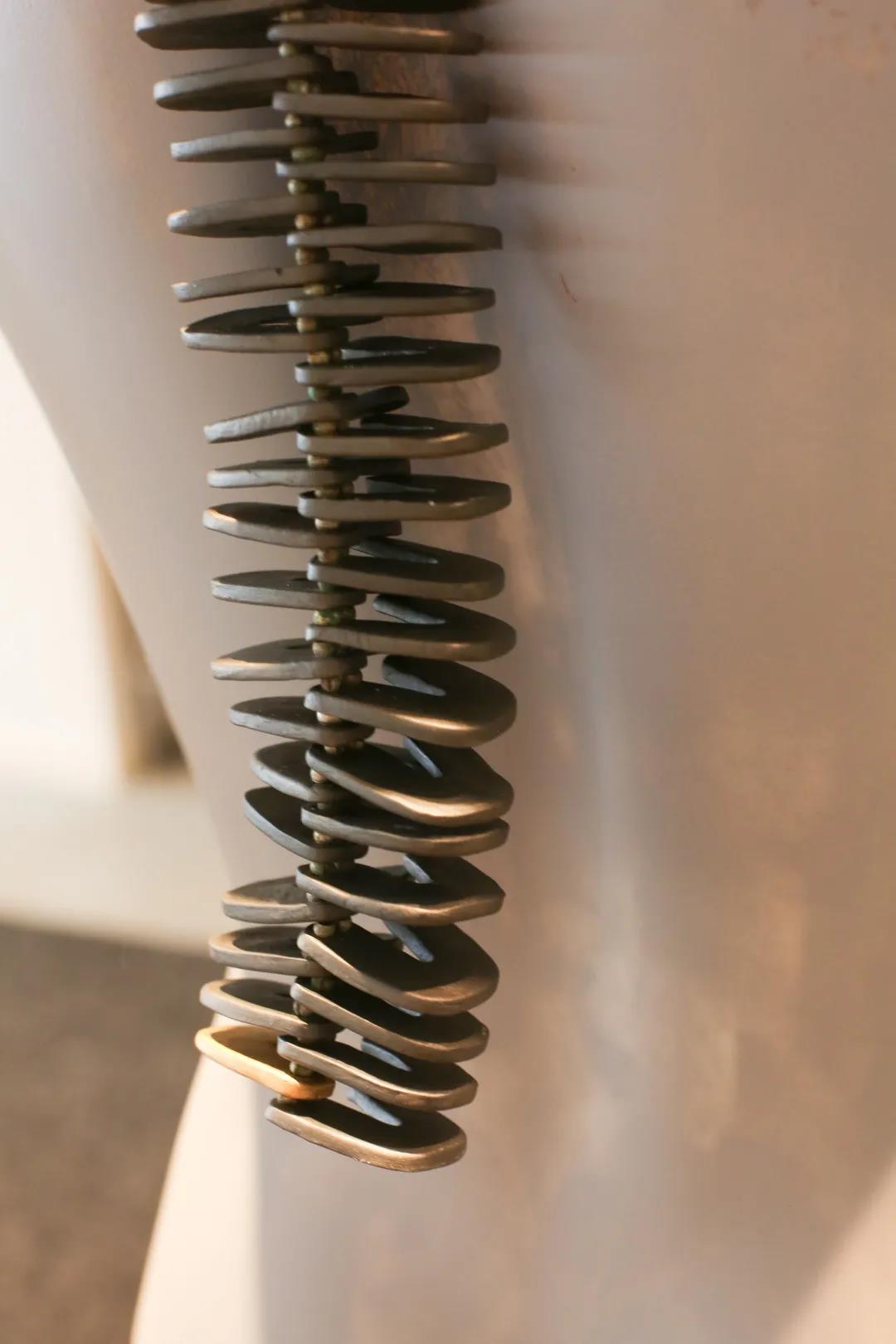
Details
細節圖
Lu: Are they also made of stone?
Lu: 他們也是由石頭制作而成的嗎?
Karin: No. It is iron beads made from bullets. The women who were in the war use bullets to make beads out of it.
Karin: 不是的,這些鐵珠是子彈做成的。戰爭中的女人用子彈來制作的這些珠子。
Karin: This work shows a kind of optimistic attitude.
Karin: 這件作品展現了一種樂觀的態度。
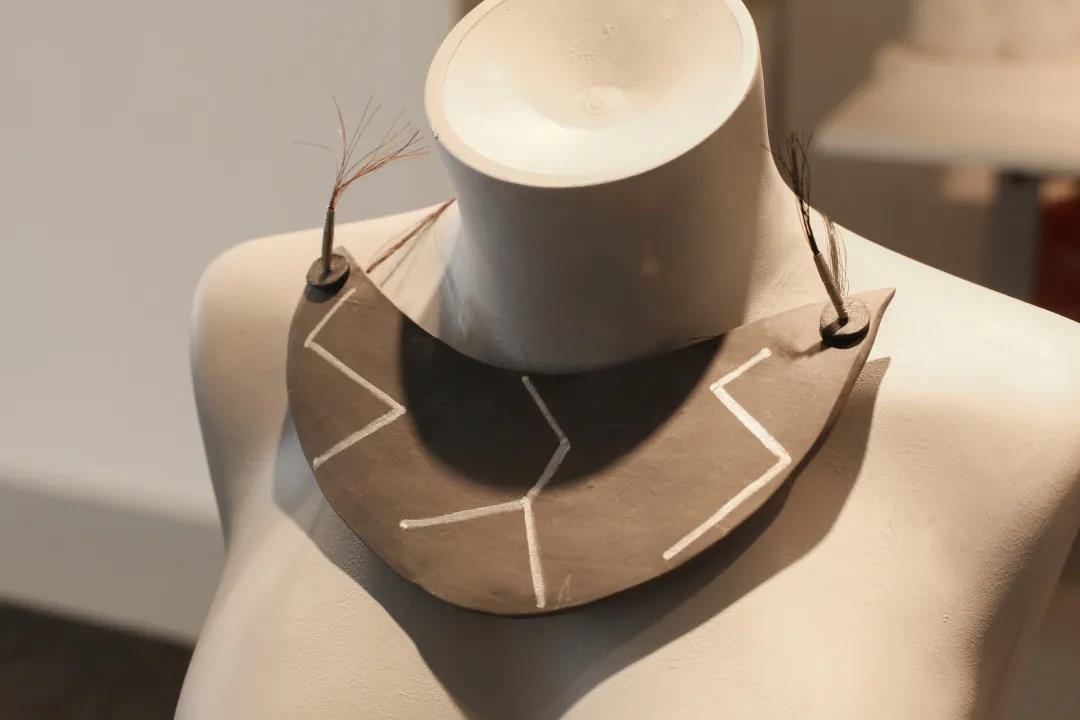
Photo by Yuxi Lu
Lu: growing up!
Lu: 向上生長!
Karin: Again, the leather of the African people in the front side. And you can see different colors of tails of the different horses.
Karin: 在正面我再次使用了來自非洲的皮革。并且你還能看見不同馬尾巴所帶有的不同毛色。
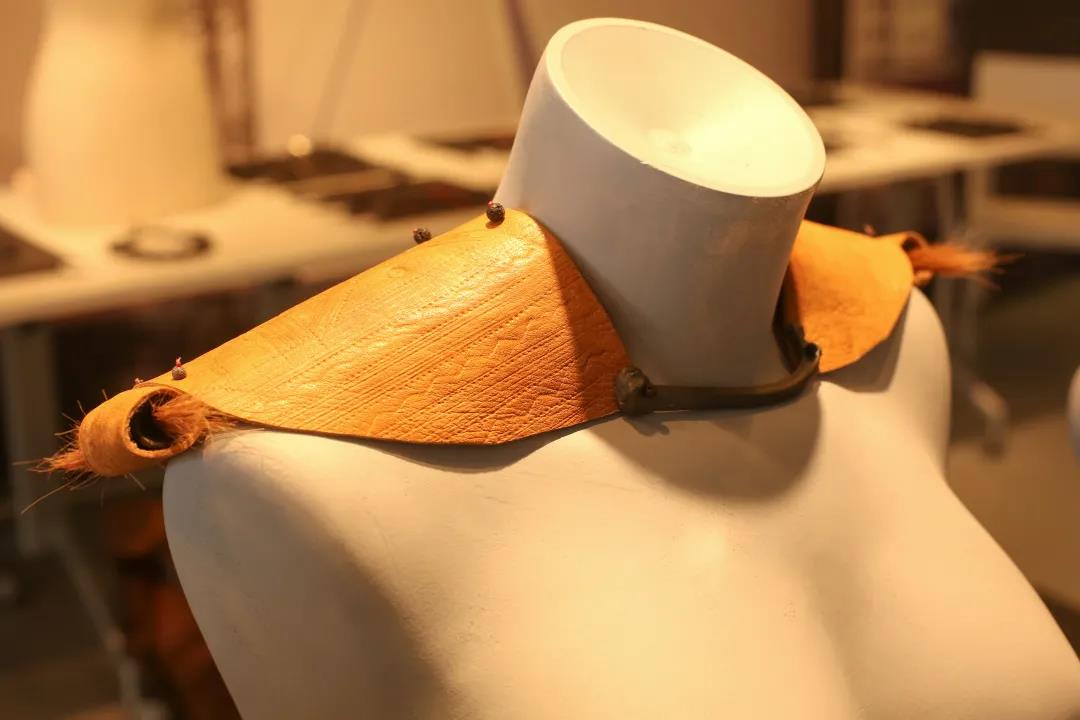
Photo by Yuxi Lu
Karin: This piece was chosen in an exhibition in the Dutch CODA Museum in the Keramiek Triënnale. They liked this one very much. Because it's open and closed at the same time. I connected two-half of the beads by putting hair through them.
Karin: 這件作品被荷蘭CODA博物館的一個陶瓷三年展選中。他們十分喜歡這件作品,因為它同時開合的狀態。我把頭發穿過兩個半球將它們連接在了一起。
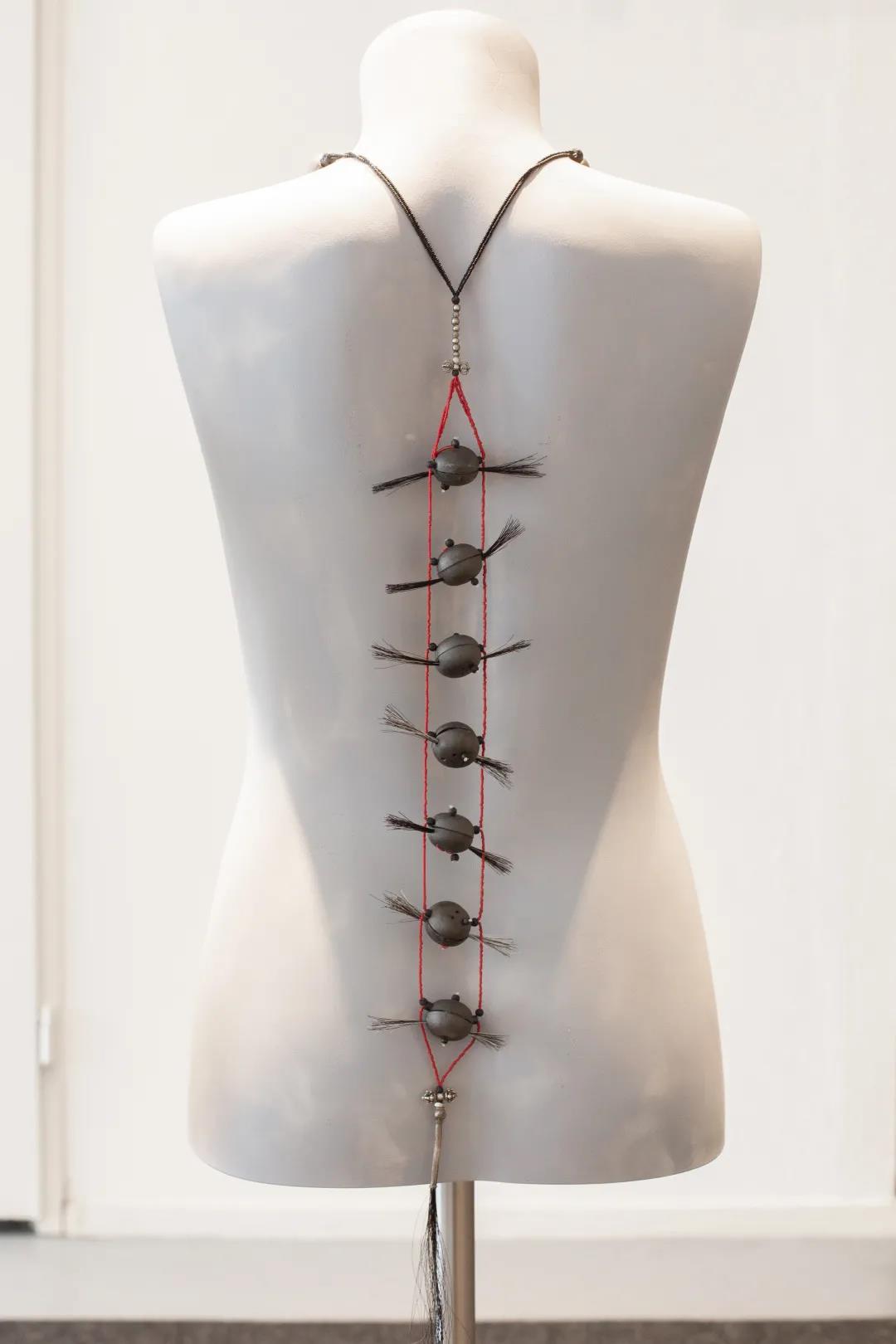
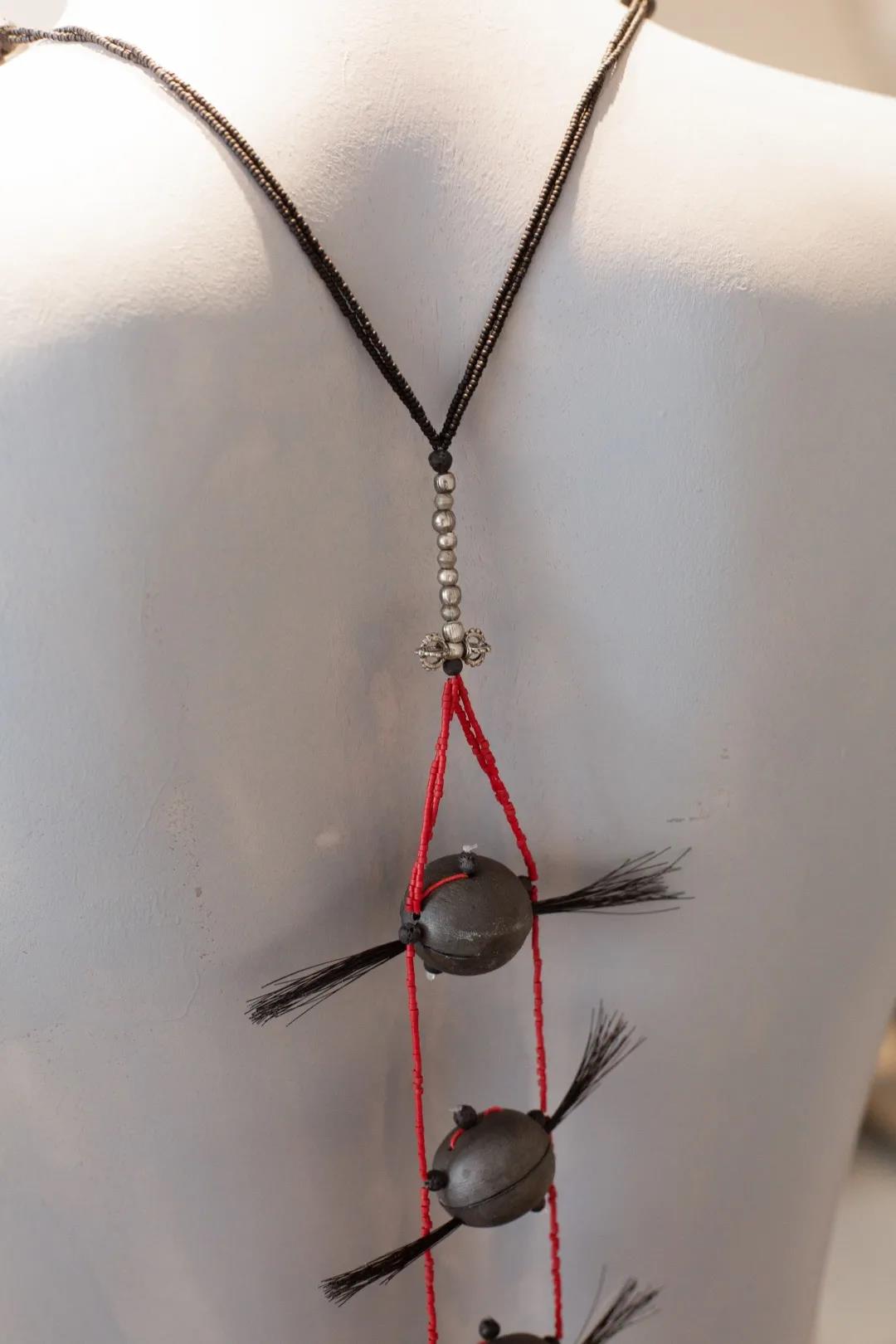
Details
細節圖
Photo by Yuxi Lu
Karin: These beads are from western Africa.
Karin: 這些珠子是來自非洲西部。
Lu: Is it also made from the bullet?
Lu: 也是由子彈制作的嗎?
Karin: No, it is not.
Karin: 不是的。
Karin: In the desert, the Toeareg have beautiful charms and beads. I pushed an amulet of the Toeareg into clay. And the negative of the shape shows up.
Karin: 在沙漠中的圖阿雷格人有許多漂亮的護身符和珠子。我把一件圖阿雷格人的護身符壓在了泥土上,隨后它的負形就浮現在了表面。
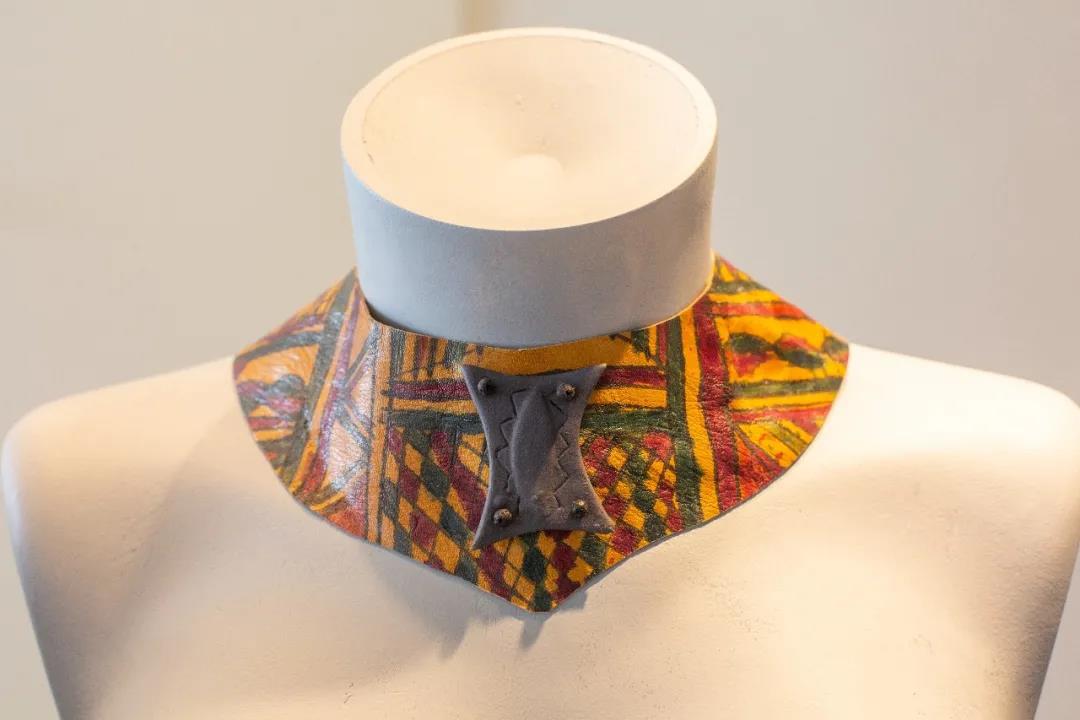
Photo by Yuxi Lu
Karin: This piece is made of pig bladder. I put all pieces together.
Karin: 這件作品是由豬皮制成,我將它們全部連在了一起。

Photo by Yuxi Lu
Lu: You cut the pieces and then connected them?
Lu: 你將它們裁剪下來然后再連接的嗎?
Karin: Yes.
Karin: 是的。
Karin: And I found it (The red object with Chinese traditional pattern in the middle) on a market of China.
Karin: 這個(位于中間有著中國傳統圖案的紅色物件)是我在中國的市場上找到的。
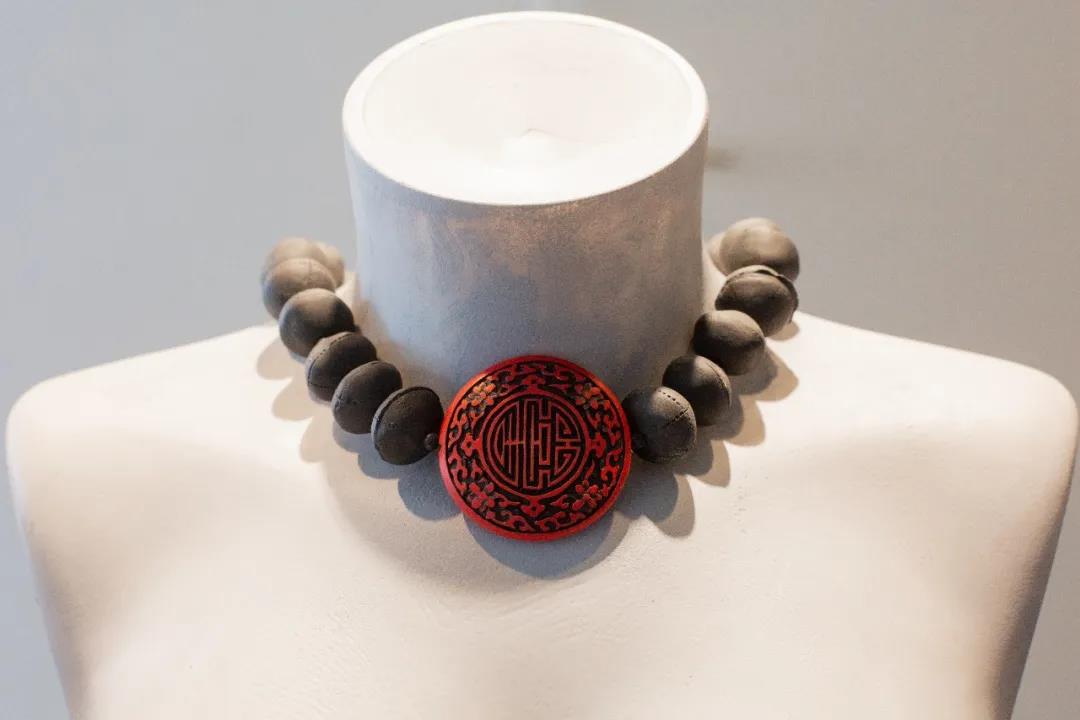
Photo by Yuxi Lu
Lu: I like the different ways you hang the beads. And the way of representing your feelings of traditional Chinese culture by using the red color which is symbol of luck.
Lu: 我很喜歡你懸掛珠子的不同方式,以及通過運用象征幸運的紅色來展現你對中國傳統文化的感受。
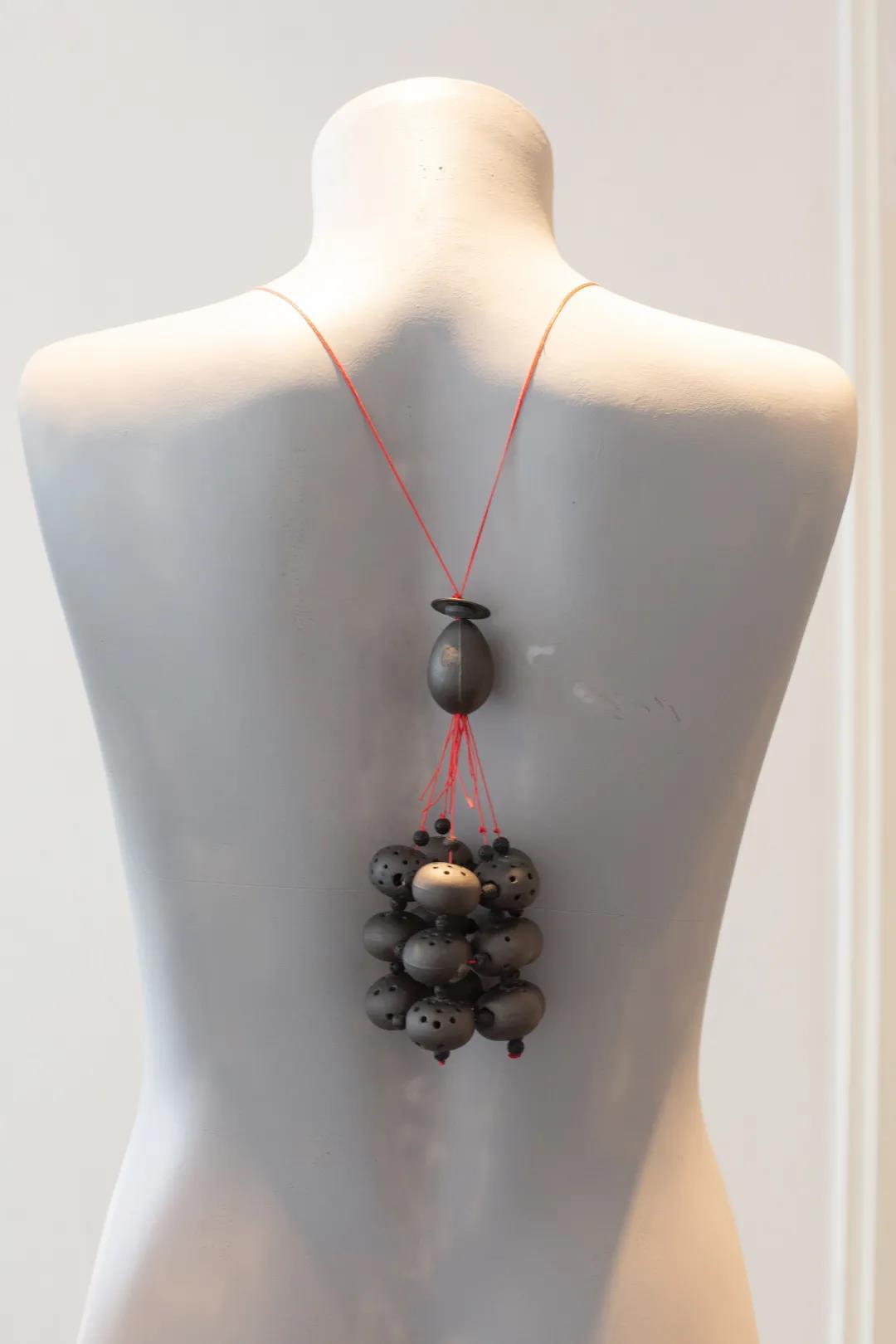
Photo by Yuxi Lu
Karin: I was making the horsehair in a repetition way. I love it. But at the same time, it is difficult to use horsehair, because it is thick and curled. Despite that, I still like to work with it.
Karin: 我不斷重復地使用馬毛。我很喜歡它。但同時使用馬毛也是十分困難的,因為它很粗也很卷。盡管如此,我仍然喜歡在作品中使用它。
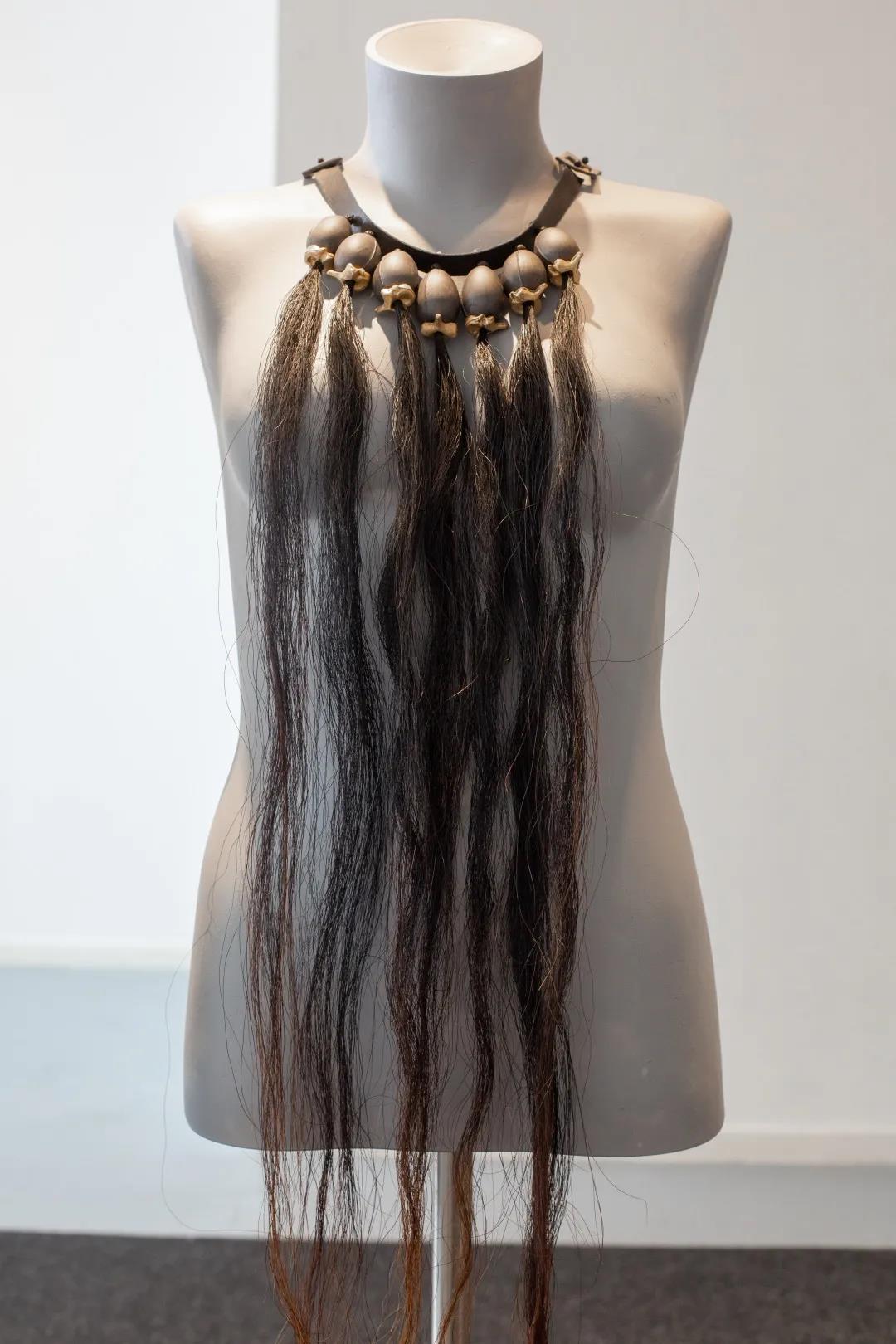
Photo by Yuxi Lu
Lu: This piece has a strong visual effect.
Lu: 這件作品有很強的視覺效果。
Karin: Yes. This one is in the front instead of back.
Karin: 是的,這件作品我把馬毛放在了身體正面而不是后背。
Karin: Then this one was the last one I made. Because I started to make this in the last few months. I thought about doing something with it. I still had pain at that time. This one is quite heavy and rough, because they are not hollow.
Karin: 這件作品是我制作的最后一件。因為這是在最近幾個月開始制作的,那個時候我仍然感到疼痛。所以我想要做點什么來表達我的感受。這一件十分沉重且粗曠,因為他們不是空心的。
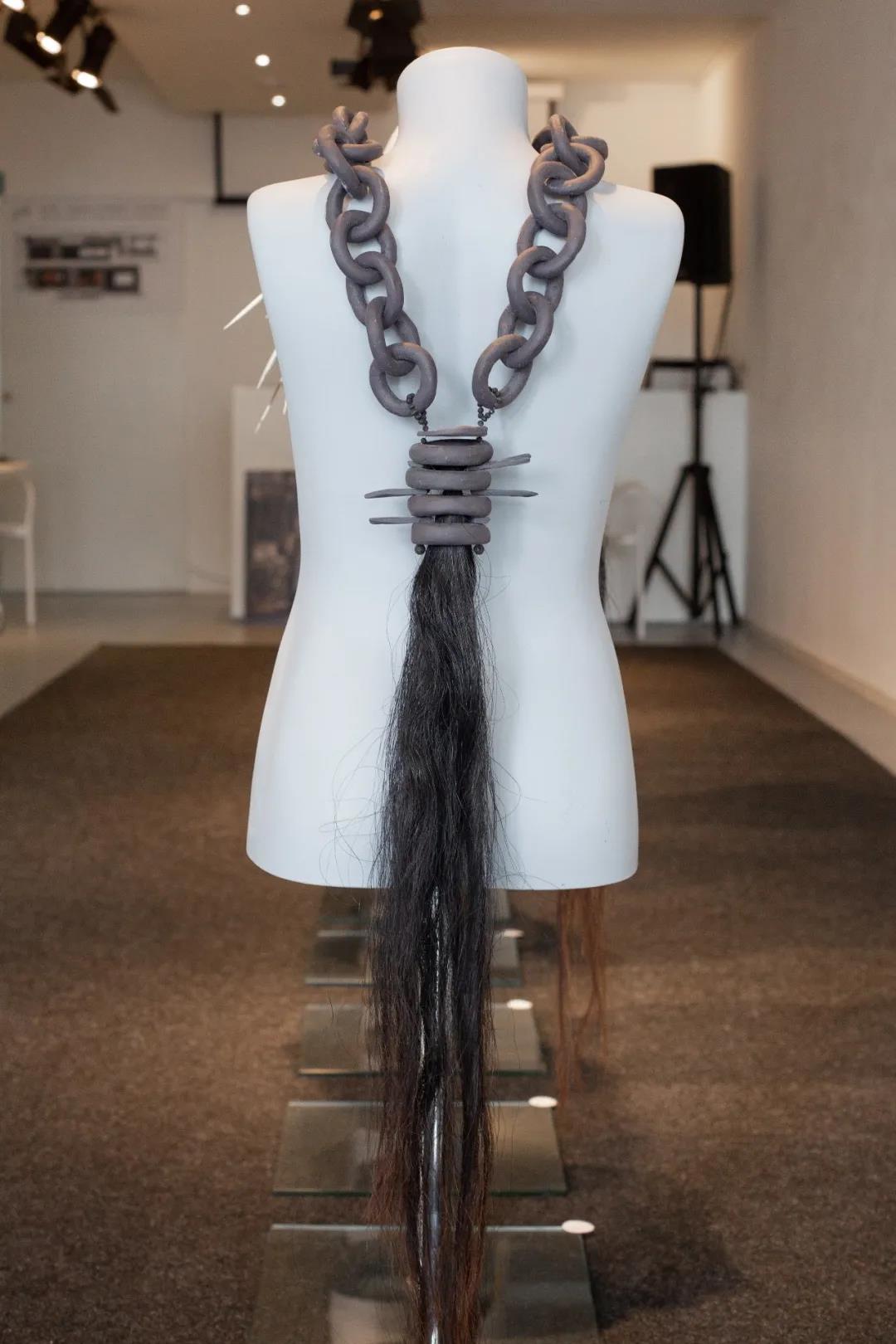
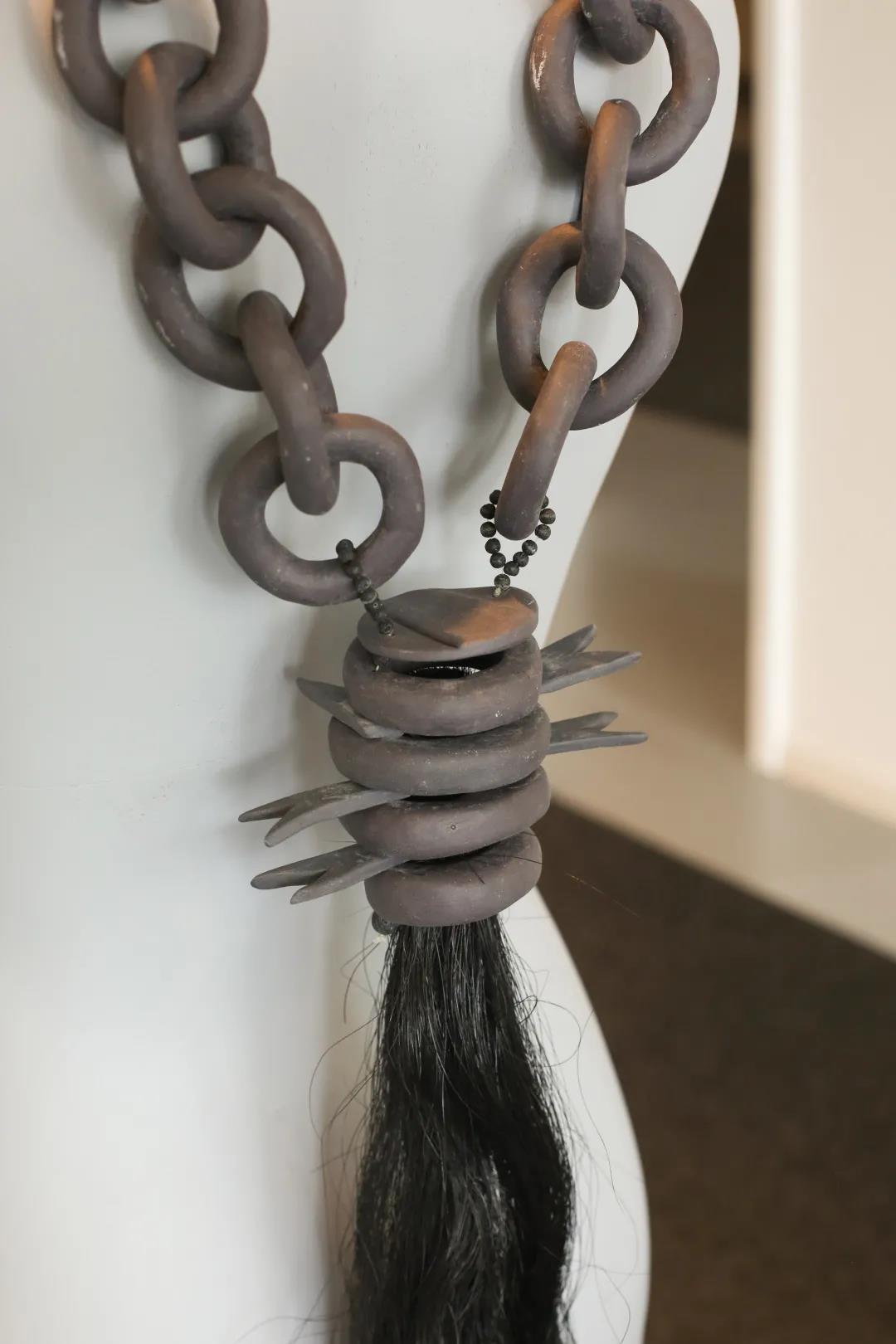
Details
細節圖
Photo by Yuxi Lu
Contacts of artist and gallery
藝術家和畫廊聯系方式:
Karin van Paassen,
curator & designer
Rietdijkstraat 52
3151 GJ Hoek van Holland
the Netherlands
+31 (0)6 24373714
kvanpaassen@upcmail.nl
www.karinvanpaassen.com
www.karinvanpaassen.jewelry
Galerie Wind
Address: Prins Hendrikkade 124a
3071 KL Rotterdam
Tel: +31 (0)10 - 233 1335
Mobile: + 31 6 546 130 95
Web: info@galeriewind.nl
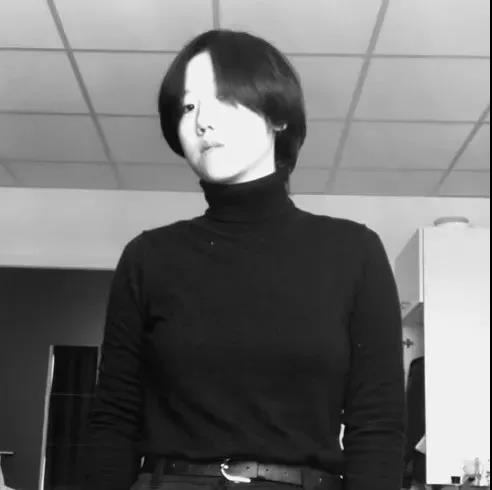
盧雨曦
特派員 / Correspondent
盧雨曦,出生于重慶。2019年畢業于四川美術學院首飾設計系,現就讀于比利時安特衛普皇家藝術學院Jewellery Design & Gold and Silversmithing專業。對中西方文化差異以及跨學科創作,如圖片攝影、影像制作、裝置藝術有濃厚興趣。
近期被這句話激勵著:
“Every Cloud Has A Silver Lining”
“烏云背后總有一絲光芒”
期待交流與學習
Ins: yuxi__lu

 AIVA公眾號
AIVA公眾號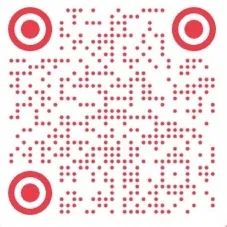 小紅書:AIVA當代首飾
小紅書:AIVA當代首飾 AIVA當代首飾
AIVA當代首飾 AIVA國際課程中心
AIVA國際課程中心 滬公網安備 31010602004641號
滬公網安備 31010602004641號